The Relationship Between Talent Management and Organizational Performance
VerifiedAdded on 2019/10/31
|18
|4741
|207
Report
AI Summary
The assignment content is a collection of articles, books, and other sources related to talent management, human resource management, and organizational performance. The main topics include the impact of HRM practices on employee commitment, the role of perceived organizational justice in shaping outcomes, and the importance of ethical standards in research. There are also sections on doing literature reviews, research methodologies, and analysis and interpretation of data.
Contribute Materials
Your contribution can guide someone’s learning journey. Share your
documents today.
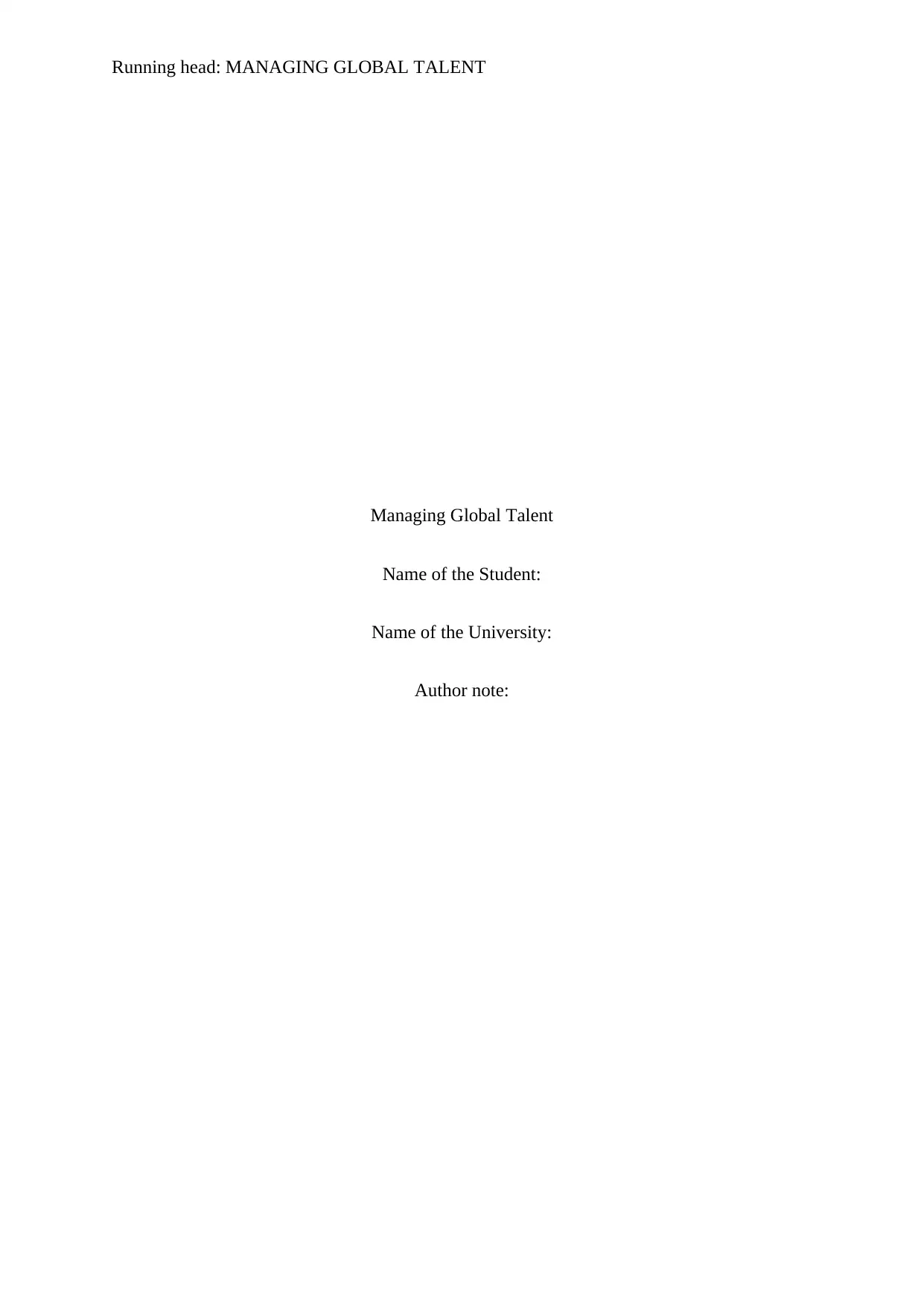
Running head: MANAGING GLOBAL TALENT
Managing Global Talent
Name of the Student:
Name of the University:
Author note:
Managing Global Talent
Name of the Student:
Name of the University:
Author note:
Secure Best Marks with AI Grader
Need help grading? Try our AI Grader for instant feedback on your assignments.
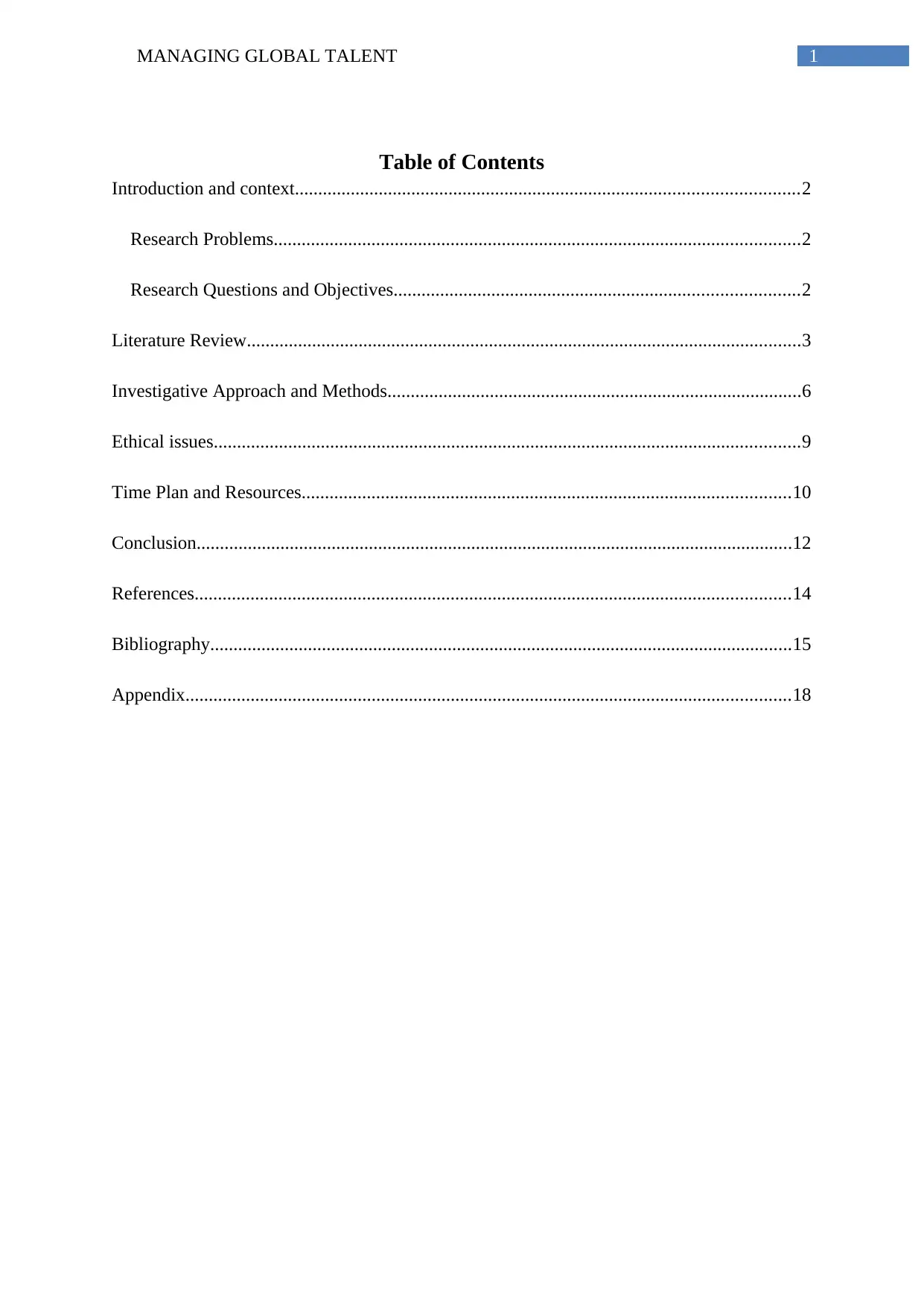
1MANAGING GLOBAL TALENT
Table of Contents
Introduction and context............................................................................................................2
Research Problems.................................................................................................................2
Research Questions and Objectives.......................................................................................2
Literature Review.......................................................................................................................3
Investigative Approach and Methods.........................................................................................6
Ethical issues..............................................................................................................................9
Time Plan and Resources.........................................................................................................10
Conclusion................................................................................................................................12
References................................................................................................................................14
Bibliography.............................................................................................................................15
Appendix..................................................................................................................................18
Table of Contents
Introduction and context............................................................................................................2
Research Problems.................................................................................................................2
Research Questions and Objectives.......................................................................................2
Literature Review.......................................................................................................................3
Investigative Approach and Methods.........................................................................................6
Ethical issues..............................................................................................................................9
Time Plan and Resources.........................................................................................................10
Conclusion................................................................................................................................12
References................................................................................................................................14
Bibliography.............................................................................................................................15
Appendix..................................................................................................................................18
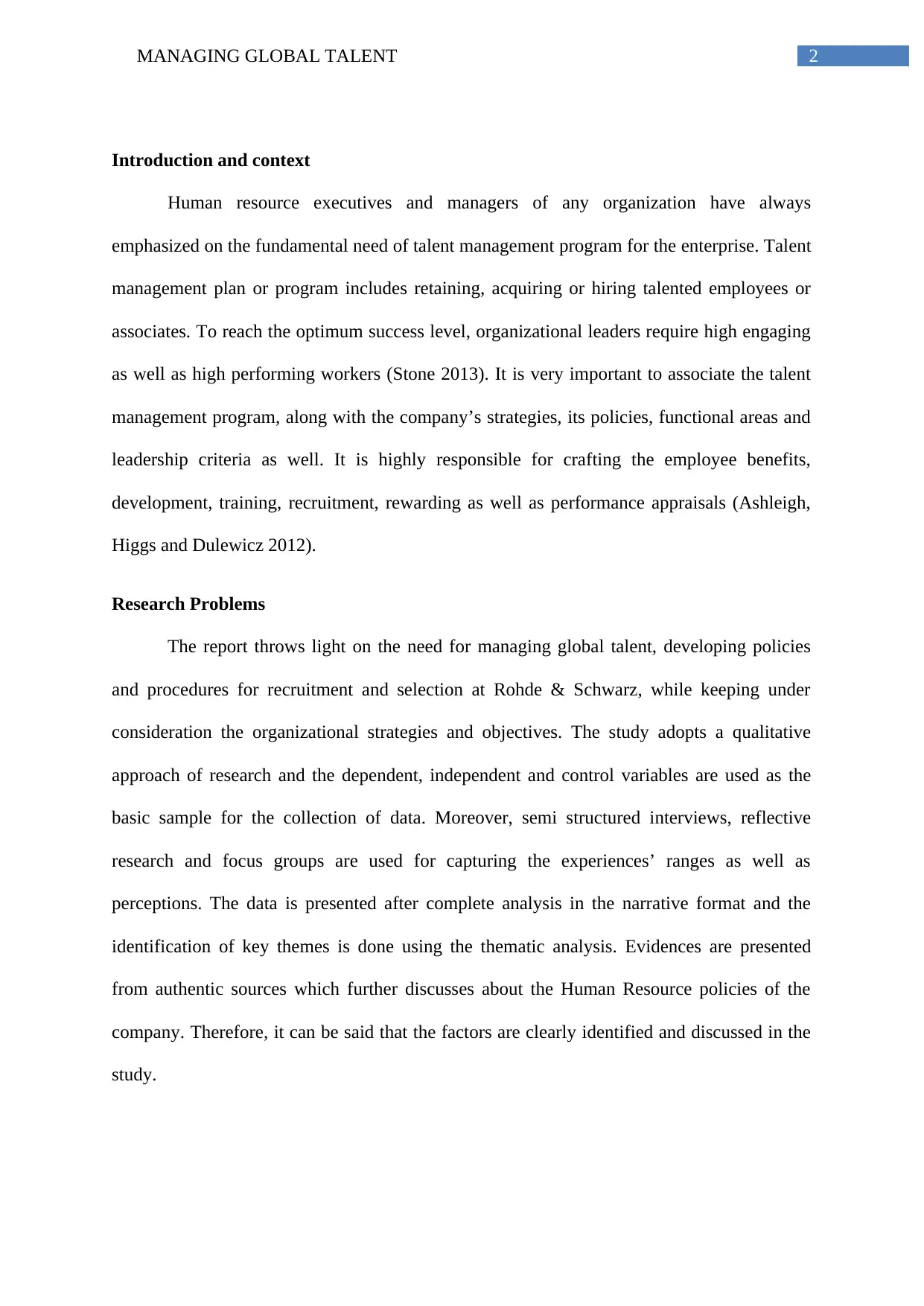
2MANAGING GLOBAL TALENT
Introduction and context
Human resource executives and managers of any organization have always
emphasized on the fundamental need of talent management program for the enterprise. Talent
management plan or program includes retaining, acquiring or hiring talented employees or
associates. To reach the optimum success level, organizational leaders require high engaging
as well as high performing workers (Stone 2013). It is very important to associate the talent
management program, along with the company’s strategies, its policies, functional areas and
leadership criteria as well. It is highly responsible for crafting the employee benefits,
development, training, recruitment, rewarding as well as performance appraisals (Ashleigh,
Higgs and Dulewicz 2012).
Research Problems
The report throws light on the need for managing global talent, developing policies
and procedures for recruitment and selection at Rohde & Schwarz, while keeping under
consideration the organizational strategies and objectives. The study adopts a qualitative
approach of research and the dependent, independent and control variables are used as the
basic sample for the collection of data. Moreover, semi structured interviews, reflective
research and focus groups are used for capturing the experiences’ ranges as well as
perceptions. The data is presented after complete analysis in the narrative format and the
identification of key themes is done using the thematic analysis. Evidences are presented
from authentic sources which further discusses about the Human Resource policies of the
company. Therefore, it can be said that the factors are clearly identified and discussed in the
study.
Introduction and context
Human resource executives and managers of any organization have always
emphasized on the fundamental need of talent management program for the enterprise. Talent
management plan or program includes retaining, acquiring or hiring talented employees or
associates. To reach the optimum success level, organizational leaders require high engaging
as well as high performing workers (Stone 2013). It is very important to associate the talent
management program, along with the company’s strategies, its policies, functional areas and
leadership criteria as well. It is highly responsible for crafting the employee benefits,
development, training, recruitment, rewarding as well as performance appraisals (Ashleigh,
Higgs and Dulewicz 2012).
Research Problems
The report throws light on the need for managing global talent, developing policies
and procedures for recruitment and selection at Rohde & Schwarz, while keeping under
consideration the organizational strategies and objectives. The study adopts a qualitative
approach of research and the dependent, independent and control variables are used as the
basic sample for the collection of data. Moreover, semi structured interviews, reflective
research and focus groups are used for capturing the experiences’ ranges as well as
perceptions. The data is presented after complete analysis in the narrative format and the
identification of key themes is done using the thematic analysis. Evidences are presented
from authentic sources which further discusses about the Human Resource policies of the
company. Therefore, it can be said that the factors are clearly identified and discussed in the
study.
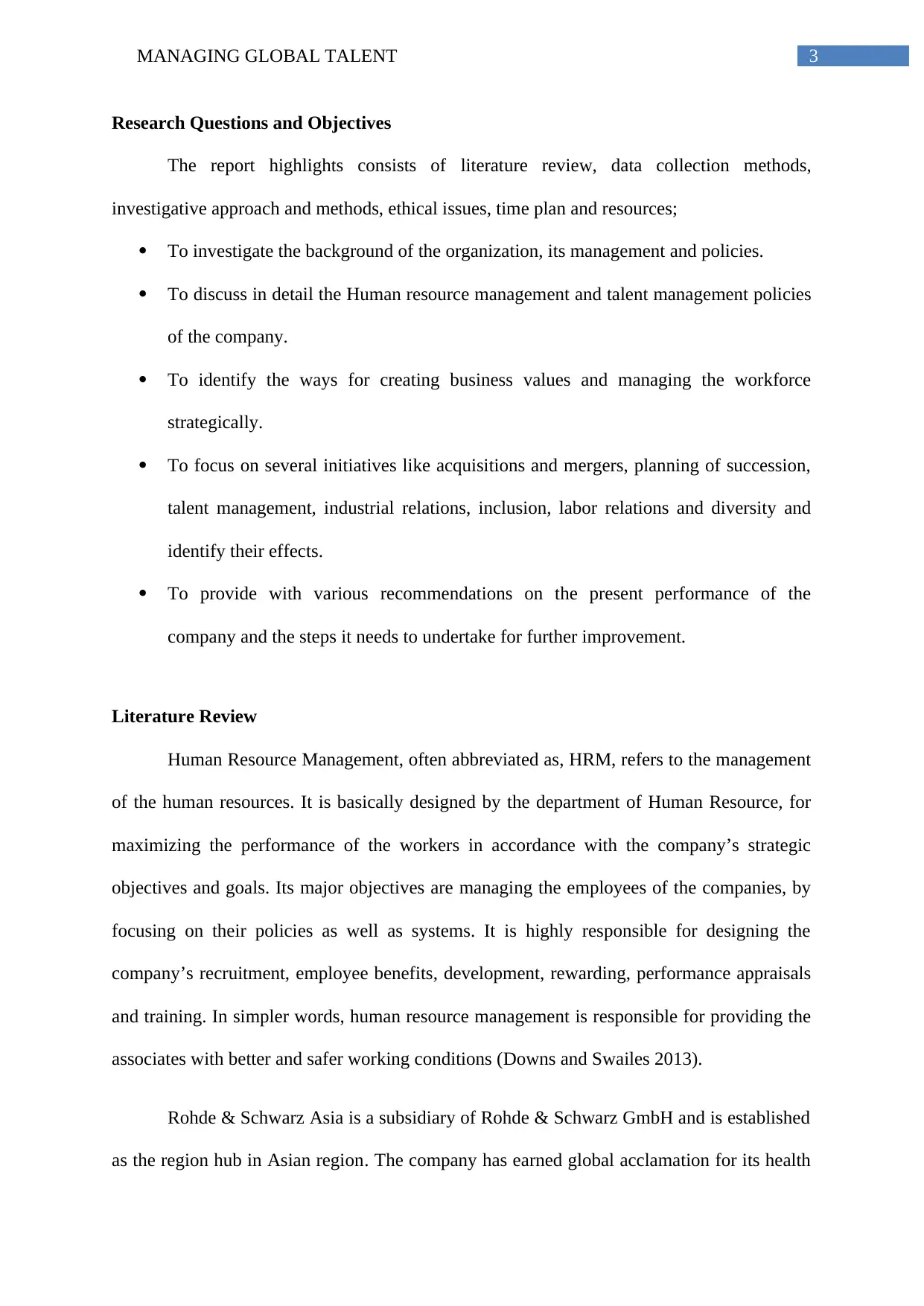
3MANAGING GLOBAL TALENT
Research Questions and Objectives
The report highlights consists of literature review, data collection methods,
investigative approach and methods, ethical issues, time plan and resources;
To investigate the background of the organization, its management and policies.
To discuss in detail the Human resource management and talent management policies
of the company.
To identify the ways for creating business values and managing the workforce
strategically.
To focus on several initiatives like acquisitions and mergers, planning of succession,
talent management, industrial relations, inclusion, labor relations and diversity and
identify their effects.
To provide with various recommendations on the present performance of the
company and the steps it needs to undertake for further improvement.
Literature Review
Human Resource Management, often abbreviated as, HRM, refers to the management
of the human resources. It is basically designed by the department of Human Resource, for
maximizing the performance of the workers in accordance with the company’s strategic
objectives and goals. Its major objectives are managing the employees of the companies, by
focusing on their policies as well as systems. It is highly responsible for designing the
company’s recruitment, employee benefits, development, rewarding, performance appraisals
and training. In simpler words, human resource management is responsible for providing the
associates with better and safer working conditions (Downs and Swailes 2013).
Rohde & Schwarz Asia is a subsidiary of Rohde & Schwarz GmbH and is established
as the region hub in Asian region. The company has earned global acclamation for its health
Research Questions and Objectives
The report highlights consists of literature review, data collection methods,
investigative approach and methods, ethical issues, time plan and resources;
To investigate the background of the organization, its management and policies.
To discuss in detail the Human resource management and talent management policies
of the company.
To identify the ways for creating business values and managing the workforce
strategically.
To focus on several initiatives like acquisitions and mergers, planning of succession,
talent management, industrial relations, inclusion, labor relations and diversity and
identify their effects.
To provide with various recommendations on the present performance of the
company and the steps it needs to undertake for further improvement.
Literature Review
Human Resource Management, often abbreviated as, HRM, refers to the management
of the human resources. It is basically designed by the department of Human Resource, for
maximizing the performance of the workers in accordance with the company’s strategic
objectives and goals. Its major objectives are managing the employees of the companies, by
focusing on their policies as well as systems. It is highly responsible for designing the
company’s recruitment, employee benefits, development, rewarding, performance appraisals
and training. In simpler words, human resource management is responsible for providing the
associates with better and safer working conditions (Downs and Swailes 2013).
Rohde & Schwarz Asia is a subsidiary of Rohde & Schwarz GmbH and is established
as the region hub in Asian region. The company has earned global acclamation for its health
Secure Best Marks with AI Grader
Need help grading? Try our AI Grader for instant feedback on your assignments.
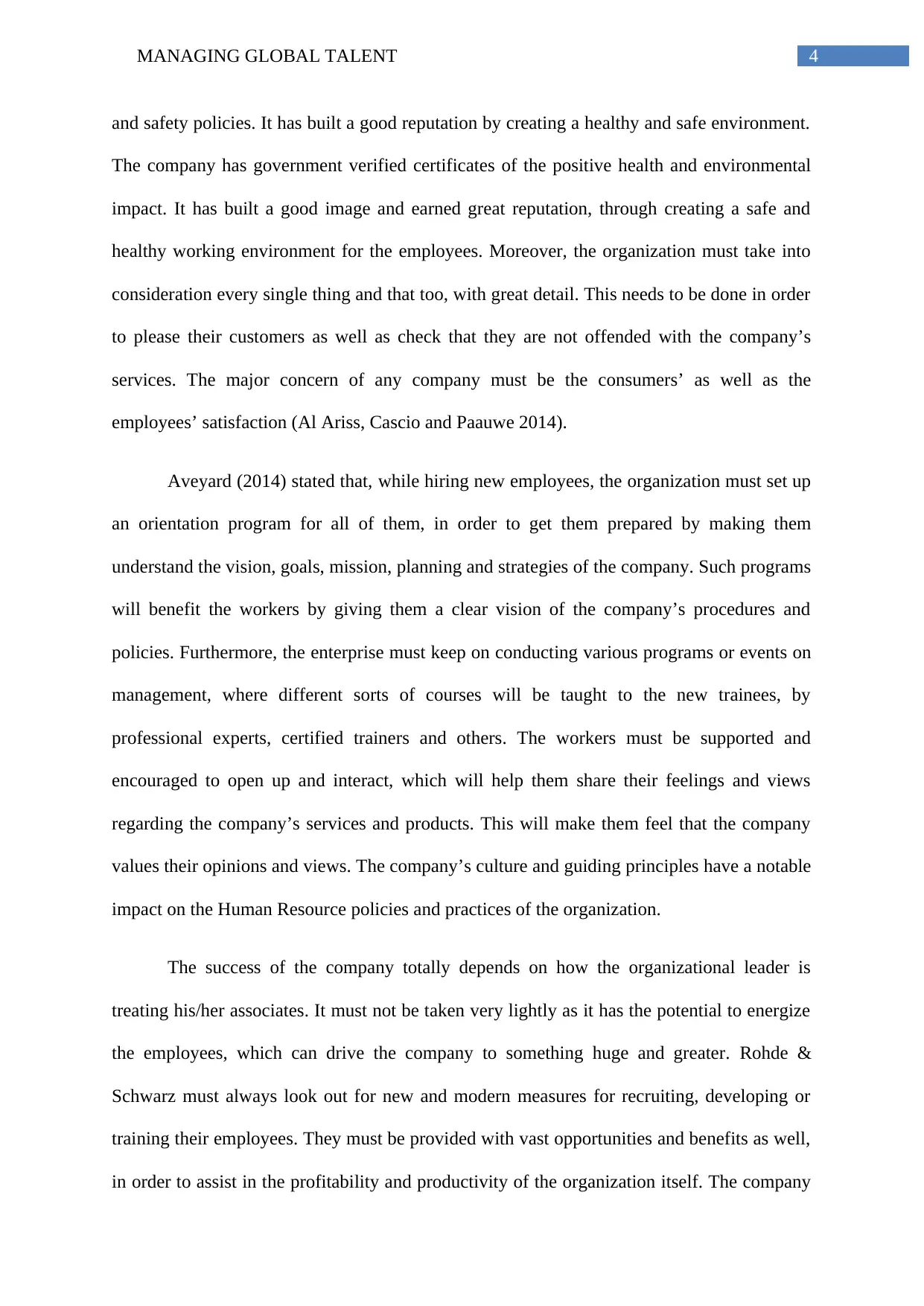
4MANAGING GLOBAL TALENT
and safety policies. It has built a good reputation by creating a healthy and safe environment.
The company has government verified certificates of the positive health and environmental
impact. It has built a good image and earned great reputation, through creating a safe and
healthy working environment for the employees. Moreover, the organization must take into
consideration every single thing and that too, with great detail. This needs to be done in order
to please their customers as well as check that they are not offended with the company’s
services. The major concern of any company must be the consumers’ as well as the
employees’ satisfaction (Al Ariss, Cascio and Paauwe 2014).
Aveyard (2014) stated that, while hiring new employees, the organization must set up
an orientation program for all of them, in order to get them prepared by making them
understand the vision, goals, mission, planning and strategies of the company. Such programs
will benefit the workers by giving them a clear vision of the company’s procedures and
policies. Furthermore, the enterprise must keep on conducting various programs or events on
management, where different sorts of courses will be taught to the new trainees, by
professional experts, certified trainers and others. The workers must be supported and
encouraged to open up and interact, which will help them share their feelings and views
regarding the company’s services and products. This will make them feel that the company
values their opinions and views. The company’s culture and guiding principles have a notable
impact on the Human Resource policies and practices of the organization.
The success of the company totally depends on how the organizational leader is
treating his/her associates. It must not be taken very lightly as it has the potential to energize
the employees, which can drive the company to something huge and greater. Rohde &
Schwarz must always look out for new and modern measures for recruiting, developing or
training their employees. They must be provided with vast opportunities and benefits as well,
in order to assist in the profitability and productivity of the organization itself. The company
and safety policies. It has built a good reputation by creating a healthy and safe environment.
The company has government verified certificates of the positive health and environmental
impact. It has built a good image and earned great reputation, through creating a safe and
healthy working environment for the employees. Moreover, the organization must take into
consideration every single thing and that too, with great detail. This needs to be done in order
to please their customers as well as check that they are not offended with the company’s
services. The major concern of any company must be the consumers’ as well as the
employees’ satisfaction (Al Ariss, Cascio and Paauwe 2014).
Aveyard (2014) stated that, while hiring new employees, the organization must set up
an orientation program for all of them, in order to get them prepared by making them
understand the vision, goals, mission, planning and strategies of the company. Such programs
will benefit the workers by giving them a clear vision of the company’s procedures and
policies. Furthermore, the enterprise must keep on conducting various programs or events on
management, where different sorts of courses will be taught to the new trainees, by
professional experts, certified trainers and others. The workers must be supported and
encouraged to open up and interact, which will help them share their feelings and views
regarding the company’s services and products. This will make them feel that the company
values their opinions and views. The company’s culture and guiding principles have a notable
impact on the Human Resource policies and practices of the organization.
The success of the company totally depends on how the organizational leader is
treating his/her associates. It must not be taken very lightly as it has the potential to energize
the employees, which can drive the company to something huge and greater. Rohde &
Schwarz must always look out for new and modern measures for recruiting, developing or
training their employees. They must be provided with vast opportunities and benefits as well,
in order to assist in the profitability and productivity of the organization itself. The company
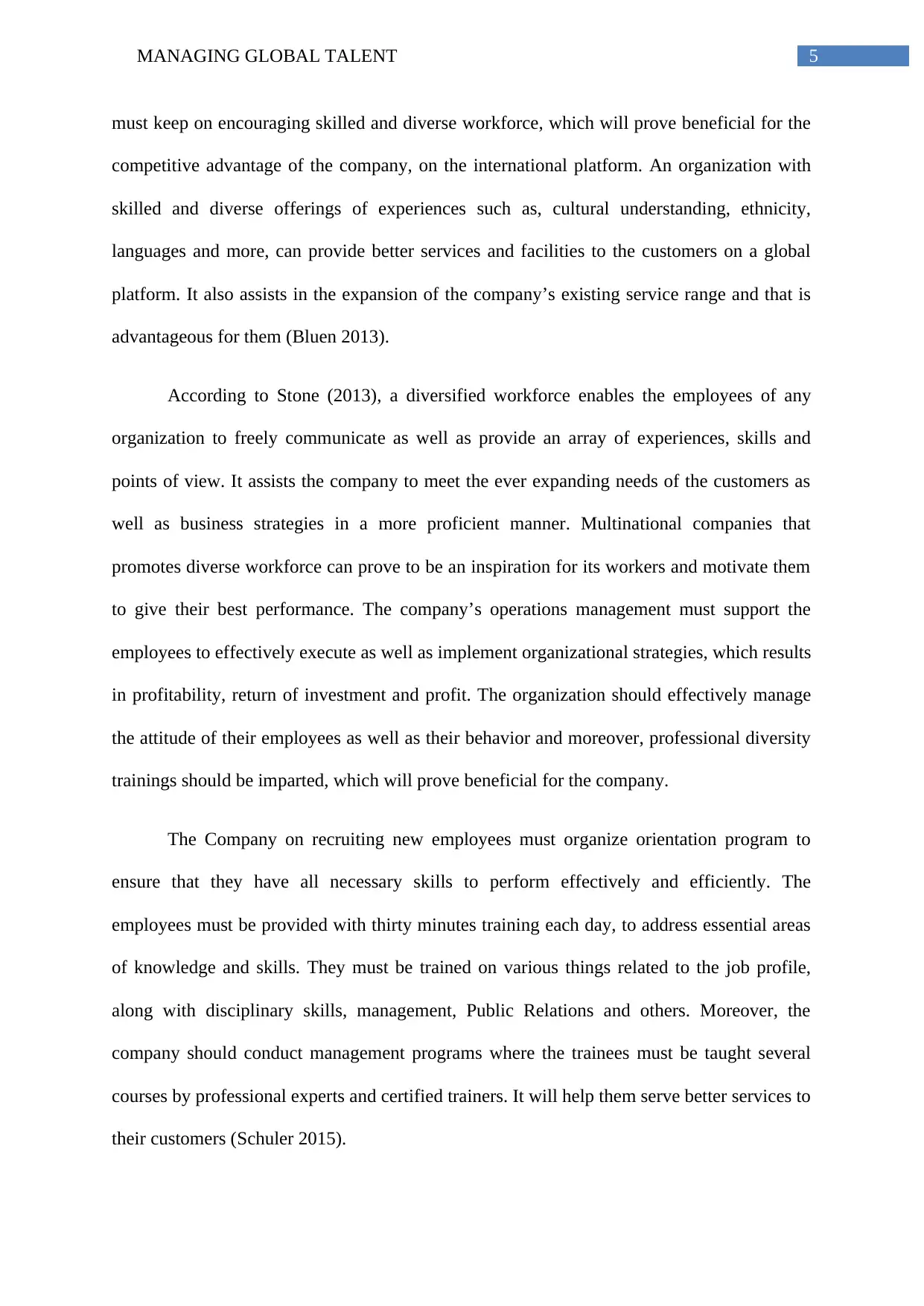
5MANAGING GLOBAL TALENT
must keep on encouraging skilled and diverse workforce, which will prove beneficial for the
competitive advantage of the company, on the international platform. An organization with
skilled and diverse offerings of experiences such as, cultural understanding, ethnicity,
languages and more, can provide better services and facilities to the customers on a global
platform. It also assists in the expansion of the company’s existing service range and that is
advantageous for them (Bluen 2013).
According to Stone (2013), a diversified workforce enables the employees of any
organization to freely communicate as well as provide an array of experiences, skills and
points of view. It assists the company to meet the ever expanding needs of the customers as
well as business strategies in a more proficient manner. Multinational companies that
promotes diverse workforce can prove to be an inspiration for its workers and motivate them
to give their best performance. The company’s operations management must support the
employees to effectively execute as well as implement organizational strategies, which results
in profitability, return of investment and profit. The organization should effectively manage
the attitude of their employees as well as their behavior and moreover, professional diversity
trainings should be imparted, which will prove beneficial for the company.
The Company on recruiting new employees must organize orientation program to
ensure that they have all necessary skills to perform effectively and efficiently. The
employees must be provided with thirty minutes training each day, to address essential areas
of knowledge and skills. They must be trained on various things related to the job profile,
along with disciplinary skills, management, Public Relations and others. Moreover, the
company should conduct management programs where the trainees must be taught several
courses by professional experts and certified trainers. It will help them serve better services to
their customers (Schuler 2015).
must keep on encouraging skilled and diverse workforce, which will prove beneficial for the
competitive advantage of the company, on the international platform. An organization with
skilled and diverse offerings of experiences such as, cultural understanding, ethnicity,
languages and more, can provide better services and facilities to the customers on a global
platform. It also assists in the expansion of the company’s existing service range and that is
advantageous for them (Bluen 2013).
According to Stone (2013), a diversified workforce enables the employees of any
organization to freely communicate as well as provide an array of experiences, skills and
points of view. It assists the company to meet the ever expanding needs of the customers as
well as business strategies in a more proficient manner. Multinational companies that
promotes diverse workforce can prove to be an inspiration for its workers and motivate them
to give their best performance. The company’s operations management must support the
employees to effectively execute as well as implement organizational strategies, which results
in profitability, return of investment and profit. The organization should effectively manage
the attitude of their employees as well as their behavior and moreover, professional diversity
trainings should be imparted, which will prove beneficial for the company.
The Company on recruiting new employees must organize orientation program to
ensure that they have all necessary skills to perform effectively and efficiently. The
employees must be provided with thirty minutes training each day, to address essential areas
of knowledge and skills. They must be trained on various things related to the job profile,
along with disciplinary skills, management, Public Relations and others. Moreover, the
company should conduct management programs where the trainees must be taught several
courses by professional experts and certified trainers. It will help them serve better services to
their customers (Schuler 2015).
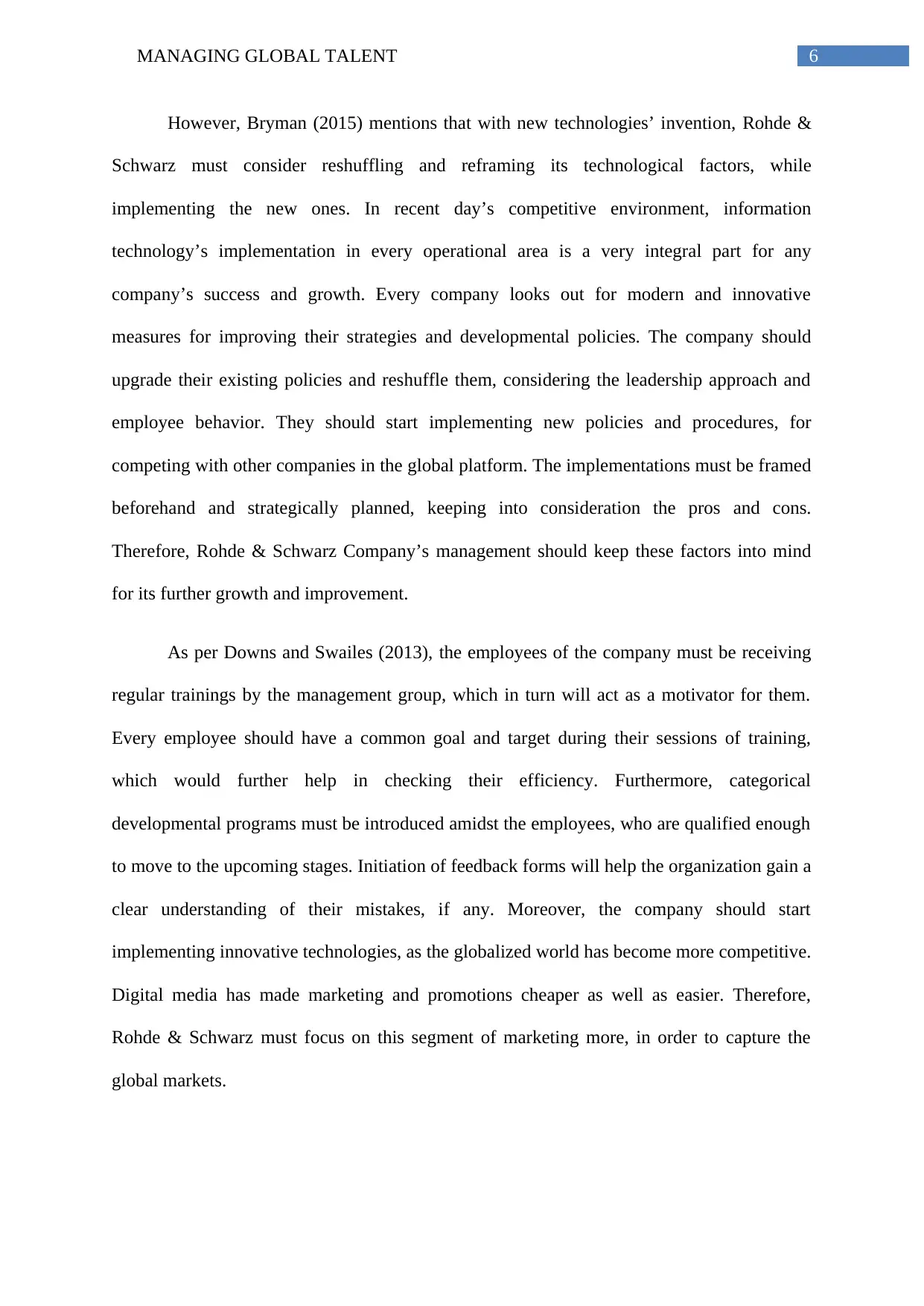
6MANAGING GLOBAL TALENT
However, Bryman (2015) mentions that with new technologies’ invention, Rohde &
Schwarz must consider reshuffling and reframing its technological factors, while
implementing the new ones. In recent day’s competitive environment, information
technology’s implementation in every operational area is a very integral part for any
company’s success and growth. Every company looks out for modern and innovative
measures for improving their strategies and developmental policies. The company should
upgrade their existing policies and reshuffle them, considering the leadership approach and
employee behavior. They should start implementing new policies and procedures, for
competing with other companies in the global platform. The implementations must be framed
beforehand and strategically planned, keeping into consideration the pros and cons.
Therefore, Rohde & Schwarz Company’s management should keep these factors into mind
for its further growth and improvement.
As per Downs and Swailes (2013), the employees of the company must be receiving
regular trainings by the management group, which in turn will act as a motivator for them.
Every employee should have a common goal and target during their sessions of training,
which would further help in checking their efficiency. Furthermore, categorical
developmental programs must be introduced amidst the employees, who are qualified enough
to move to the upcoming stages. Initiation of feedback forms will help the organization gain a
clear understanding of their mistakes, if any. Moreover, the company should start
implementing innovative technologies, as the globalized world has become more competitive.
Digital media has made marketing and promotions cheaper as well as easier. Therefore,
Rohde & Schwarz must focus on this segment of marketing more, in order to capture the
global markets.
However, Bryman (2015) mentions that with new technologies’ invention, Rohde &
Schwarz must consider reshuffling and reframing its technological factors, while
implementing the new ones. In recent day’s competitive environment, information
technology’s implementation in every operational area is a very integral part for any
company’s success and growth. Every company looks out for modern and innovative
measures for improving their strategies and developmental policies. The company should
upgrade their existing policies and reshuffle them, considering the leadership approach and
employee behavior. They should start implementing new policies and procedures, for
competing with other companies in the global platform. The implementations must be framed
beforehand and strategically planned, keeping into consideration the pros and cons.
Therefore, Rohde & Schwarz Company’s management should keep these factors into mind
for its further growth and improvement.
As per Downs and Swailes (2013), the employees of the company must be receiving
regular trainings by the management group, which in turn will act as a motivator for them.
Every employee should have a common goal and target during their sessions of training,
which would further help in checking their efficiency. Furthermore, categorical
developmental programs must be introduced amidst the employees, who are qualified enough
to move to the upcoming stages. Initiation of feedback forms will help the organization gain a
clear understanding of their mistakes, if any. Moreover, the company should start
implementing innovative technologies, as the globalized world has become more competitive.
Digital media has made marketing and promotions cheaper as well as easier. Therefore,
Rohde & Schwarz must focus on this segment of marketing more, in order to capture the
global markets.
Paraphrase This Document
Need a fresh take? Get an instant paraphrase of this document with our AI Paraphraser
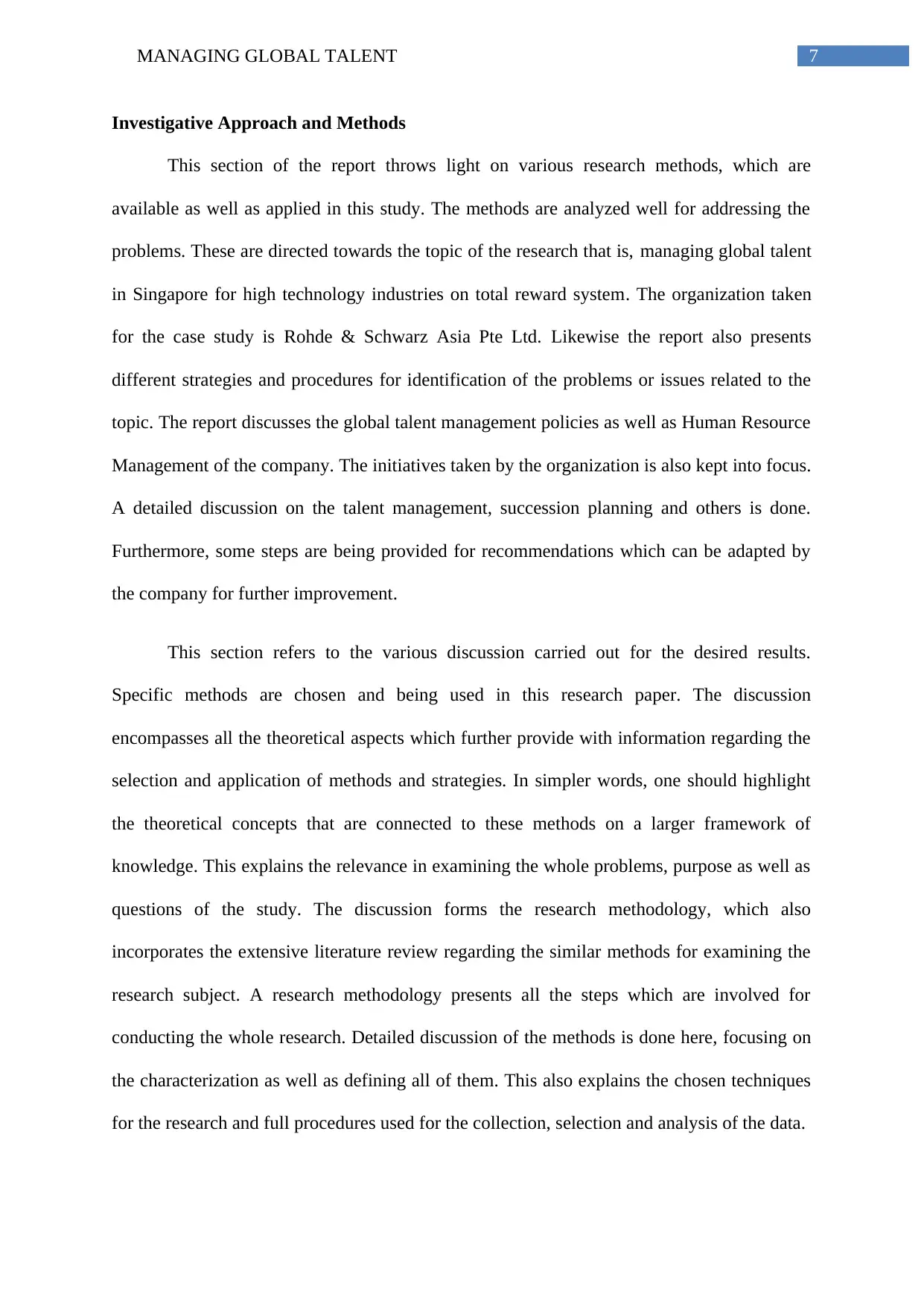
7MANAGING GLOBAL TALENT
Investigative Approach and Methods
This section of the report throws light on various research methods, which are
available as well as applied in this study. The methods are analyzed well for addressing the
problems. These are directed towards the topic of the research that is, managing global talent
in Singapore for high technology industries on total reward system. The organization taken
for the case study is Rohde & Schwarz Asia Pte Ltd. Likewise the report also presents
different strategies and procedures for identification of the problems or issues related to the
topic. The report discusses the global talent management policies as well as Human Resource
Management of the company. The initiatives taken by the organization is also kept into focus.
A detailed discussion on the talent management, succession planning and others is done.
Furthermore, some steps are being provided for recommendations which can be adapted by
the company for further improvement.
This section refers to the various discussion carried out for the desired results.
Specific methods are chosen and being used in this research paper. The discussion
encompasses all the theoretical aspects which further provide with information regarding the
selection and application of methods and strategies. In simpler words, one should highlight
the theoretical concepts that are connected to these methods on a larger framework of
knowledge. This explains the relevance in examining the whole problems, purpose as well as
questions of the study. The discussion forms the research methodology, which also
incorporates the extensive literature review regarding the similar methods for examining the
research subject. A research methodology presents all the steps which are involved for
conducting the whole research. Detailed discussion of the methods is done here, focusing on
the characterization as well as defining all of them. This also explains the chosen techniques
for the research and full procedures used for the collection, selection and analysis of the data.
Investigative Approach and Methods
This section of the report throws light on various research methods, which are
available as well as applied in this study. The methods are analyzed well for addressing the
problems. These are directed towards the topic of the research that is, managing global talent
in Singapore for high technology industries on total reward system. The organization taken
for the case study is Rohde & Schwarz Asia Pte Ltd. Likewise the report also presents
different strategies and procedures for identification of the problems or issues related to the
topic. The report discusses the global talent management policies as well as Human Resource
Management of the company. The initiatives taken by the organization is also kept into focus.
A detailed discussion on the talent management, succession planning and others is done.
Furthermore, some steps are being provided for recommendations which can be adapted by
the company for further improvement.
This section refers to the various discussion carried out for the desired results.
Specific methods are chosen and being used in this research paper. The discussion
encompasses all the theoretical aspects which further provide with information regarding the
selection and application of methods and strategies. In simpler words, one should highlight
the theoretical concepts that are connected to these methods on a larger framework of
knowledge. This explains the relevance in examining the whole problems, purpose as well as
questions of the study. The discussion forms the research methodology, which also
incorporates the extensive literature review regarding the similar methods for examining the
research subject. A research methodology presents all the steps which are involved for
conducting the whole research. Detailed discussion of the methods is done here, focusing on
the characterization as well as defining all of them. This also explains the chosen techniques
for the research and full procedures used for the collection, selection and analysis of the data.
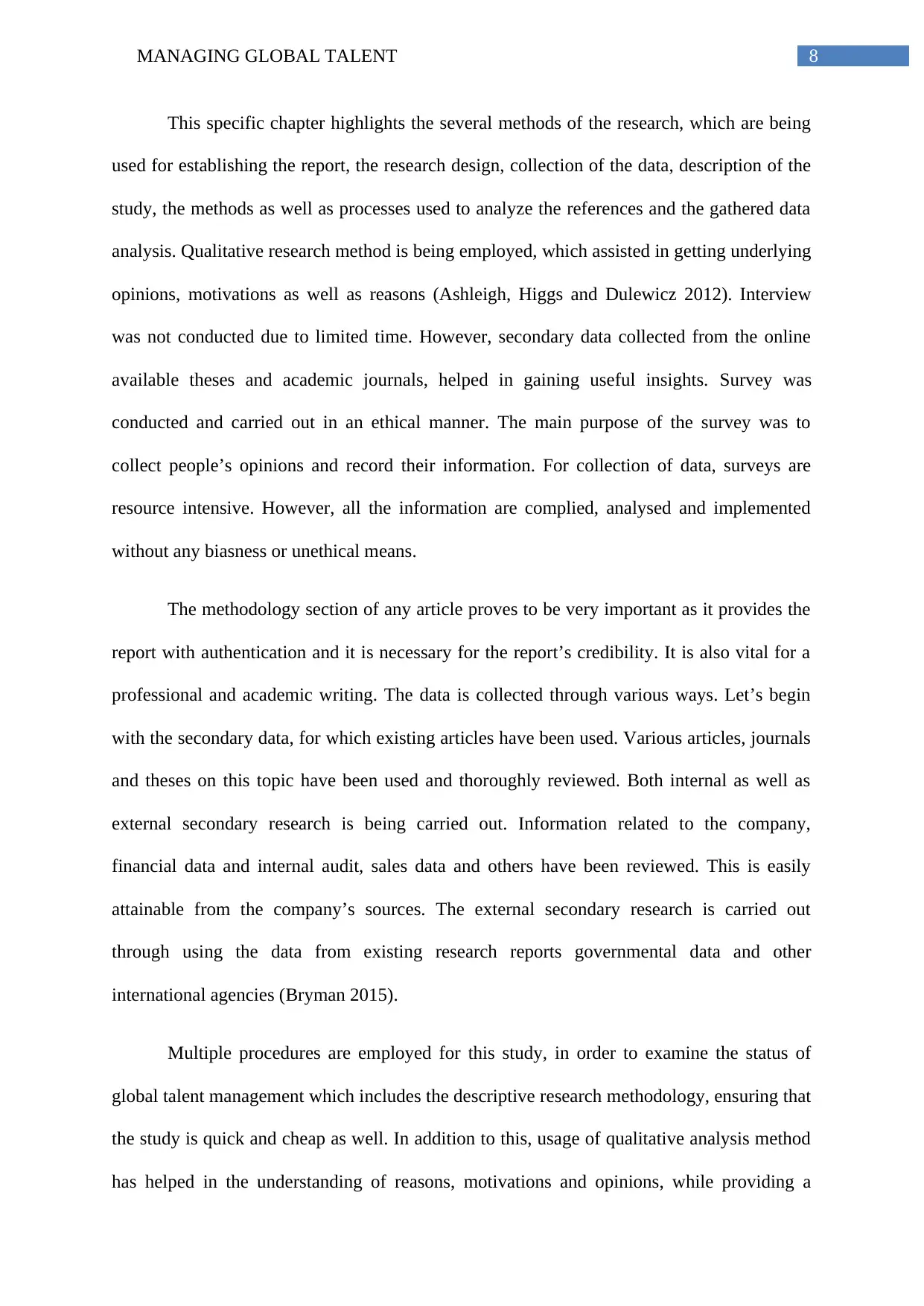
8MANAGING GLOBAL TALENT
This specific chapter highlights the several methods of the research, which are being
used for establishing the report, the research design, collection of the data, description of the
study, the methods as well as processes used to analyze the references and the gathered data
analysis. Qualitative research method is being employed, which assisted in getting underlying
opinions, motivations as well as reasons (Ashleigh, Higgs and Dulewicz 2012). Interview
was not conducted due to limited time. However, secondary data collected from the online
available theses and academic journals, helped in gaining useful insights. Survey was
conducted and carried out in an ethical manner. The main purpose of the survey was to
collect people’s opinions and record their information. For collection of data, surveys are
resource intensive. However, all the information are complied, analysed and implemented
without any biasness or unethical means.
The methodology section of any article proves to be very important as it provides the
report with authentication and it is necessary for the report’s credibility. It is also vital for a
professional and academic writing. The data is collected through various ways. Let’s begin
with the secondary data, for which existing articles have been used. Various articles, journals
and theses on this topic have been used and thoroughly reviewed. Both internal as well as
external secondary research is being carried out. Information related to the company,
financial data and internal audit, sales data and others have been reviewed. This is easily
attainable from the company’s sources. The external secondary research is carried out
through using the data from existing research reports governmental data and other
international agencies (Bryman 2015).
Multiple procedures are employed for this study, in order to examine the status of
global talent management which includes the descriptive research methodology, ensuring that
the study is quick and cheap as well. In addition to this, usage of qualitative analysis method
has helped in the understanding of reasons, motivations and opinions, while providing a
This specific chapter highlights the several methods of the research, which are being
used for establishing the report, the research design, collection of the data, description of the
study, the methods as well as processes used to analyze the references and the gathered data
analysis. Qualitative research method is being employed, which assisted in getting underlying
opinions, motivations as well as reasons (Ashleigh, Higgs and Dulewicz 2012). Interview
was not conducted due to limited time. However, secondary data collected from the online
available theses and academic journals, helped in gaining useful insights. Survey was
conducted and carried out in an ethical manner. The main purpose of the survey was to
collect people’s opinions and record their information. For collection of data, surveys are
resource intensive. However, all the information are complied, analysed and implemented
without any biasness or unethical means.
The methodology section of any article proves to be very important as it provides the
report with authentication and it is necessary for the report’s credibility. It is also vital for a
professional and academic writing. The data is collected through various ways. Let’s begin
with the secondary data, for which existing articles have been used. Various articles, journals
and theses on this topic have been used and thoroughly reviewed. Both internal as well as
external secondary research is being carried out. Information related to the company,
financial data and internal audit, sales data and others have been reviewed. This is easily
attainable from the company’s sources. The external secondary research is carried out
through using the data from existing research reports governmental data and other
international agencies (Bryman 2015).
Multiple procedures are employed for this study, in order to examine the status of
global talent management which includes the descriptive research methodology, ensuring that
the study is quick and cheap as well. In addition to this, usage of qualitative analysis method
has helped in the understanding of reasons, motivations and opinions, while providing a
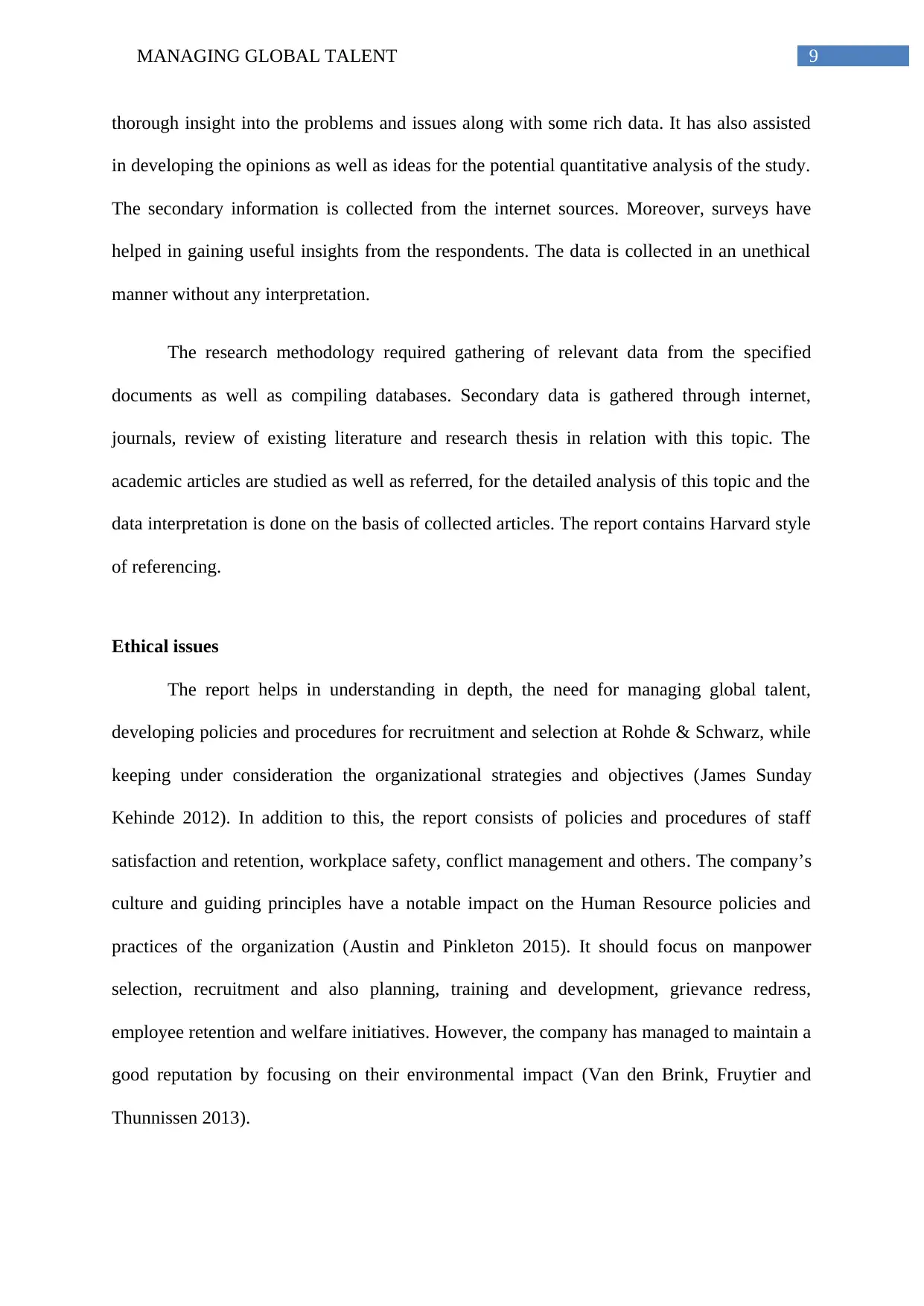
9MANAGING GLOBAL TALENT
thorough insight into the problems and issues along with some rich data. It has also assisted
in developing the opinions as well as ideas for the potential quantitative analysis of the study.
The secondary information is collected from the internet sources. Moreover, surveys have
helped in gaining useful insights from the respondents. The data is collected in an unethical
manner without any interpretation.
The research methodology required gathering of relevant data from the specified
documents as well as compiling databases. Secondary data is gathered through internet,
journals, review of existing literature and research thesis in relation with this topic. The
academic articles are studied as well as referred, for the detailed analysis of this topic and the
data interpretation is done on the basis of collected articles. The report contains Harvard style
of referencing.
Ethical issues
The report helps in understanding in depth, the need for managing global talent,
developing policies and procedures for recruitment and selection at Rohde & Schwarz, while
keeping under consideration the organizational strategies and objectives (James Sunday
Kehinde 2012). In addition to this, the report consists of policies and procedures of staff
satisfaction and retention, workplace safety, conflict management and others. The company’s
culture and guiding principles have a notable impact on the Human Resource policies and
practices of the organization (Austin and Pinkleton 2015). It should focus on manpower
selection, recruitment and also planning, training and development, grievance redress,
employee retention and welfare initiatives. However, the company has managed to maintain a
good reputation by focusing on their environmental impact (Van den Brink, Fruytier and
Thunnissen 2013).
thorough insight into the problems and issues along with some rich data. It has also assisted
in developing the opinions as well as ideas for the potential quantitative analysis of the study.
The secondary information is collected from the internet sources. Moreover, surveys have
helped in gaining useful insights from the respondents. The data is collected in an unethical
manner without any interpretation.
The research methodology required gathering of relevant data from the specified
documents as well as compiling databases. Secondary data is gathered through internet,
journals, review of existing literature and research thesis in relation with this topic. The
academic articles are studied as well as referred, for the detailed analysis of this topic and the
data interpretation is done on the basis of collected articles. The report contains Harvard style
of referencing.
Ethical issues
The report helps in understanding in depth, the need for managing global talent,
developing policies and procedures for recruitment and selection at Rohde & Schwarz, while
keeping under consideration the organizational strategies and objectives (James Sunday
Kehinde 2012). In addition to this, the report consists of policies and procedures of staff
satisfaction and retention, workplace safety, conflict management and others. The company’s
culture and guiding principles have a notable impact on the Human Resource policies and
practices of the organization (Austin and Pinkleton 2015). It should focus on manpower
selection, recruitment and also planning, training and development, grievance redress,
employee retention and welfare initiatives. However, the company has managed to maintain a
good reputation by focusing on their environmental impact (Van den Brink, Fruytier and
Thunnissen 2013).
Secure Best Marks with AI Grader
Need help grading? Try our AI Grader for instant feedback on your assignments.
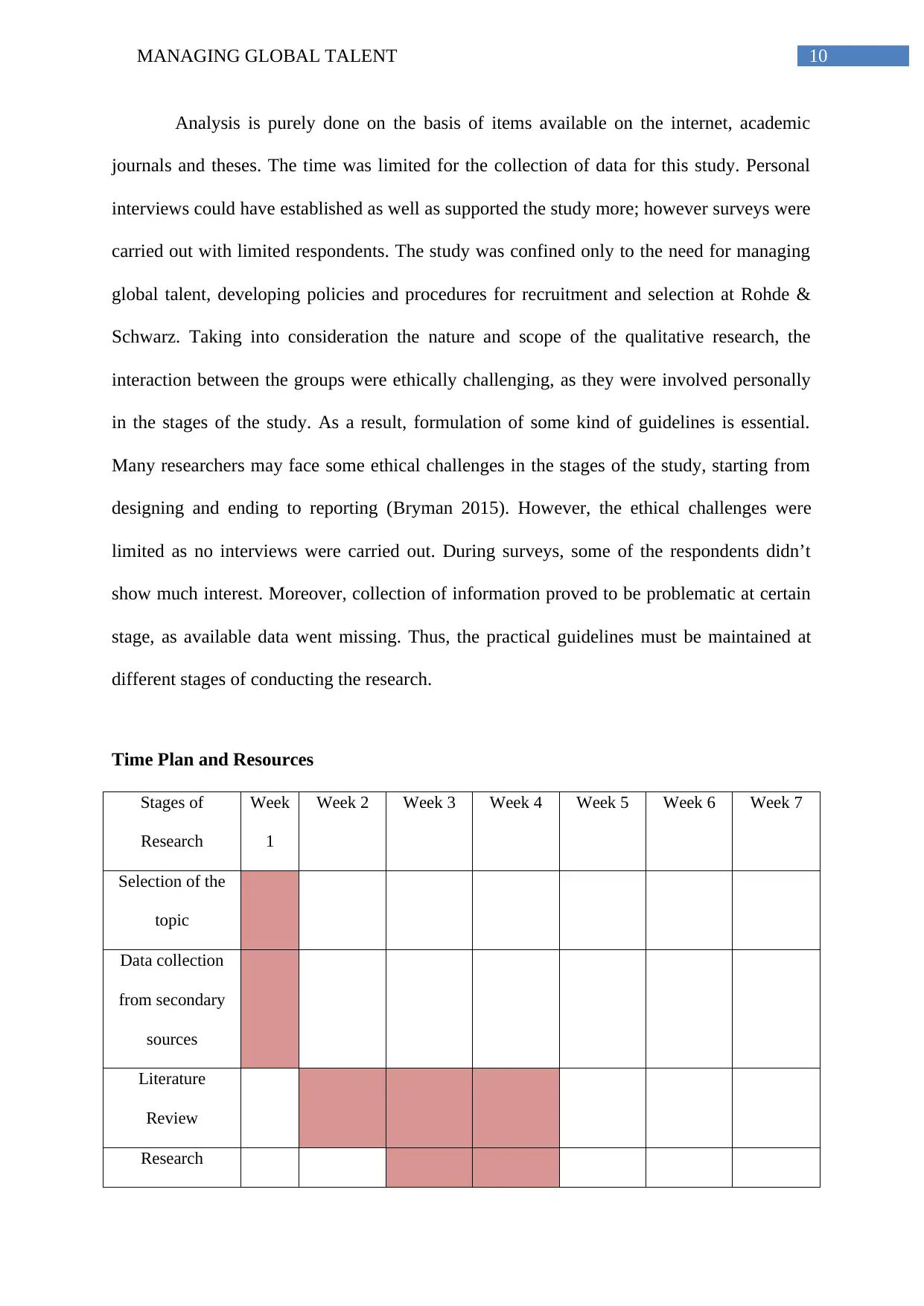
10MANAGING GLOBAL TALENT
Analysis is purely done on the basis of items available on the internet, academic
journals and theses. The time was limited for the collection of data for this study. Personal
interviews could have established as well as supported the study more; however surveys were
carried out with limited respondents. The study was confined only to the need for managing
global talent, developing policies and procedures for recruitment and selection at Rohde &
Schwarz. Taking into consideration the nature and scope of the qualitative research, the
interaction between the groups were ethically challenging, as they were involved personally
in the stages of the study. As a result, formulation of some kind of guidelines is essential.
Many researchers may face some ethical challenges in the stages of the study, starting from
designing and ending to reporting (Bryman 2015). However, the ethical challenges were
limited as no interviews were carried out. During surveys, some of the respondents didn’t
show much interest. Moreover, collection of information proved to be problematic at certain
stage, as available data went missing. Thus, the practical guidelines must be maintained at
different stages of conducting the research.
Time Plan and Resources
Stages of
Research
Week
1
Week 2 Week 3 Week 4 Week 5 Week 6 Week 7
Selection of the
topic
Data collection
from secondary
sources
Literature
Review
Research
Analysis is purely done on the basis of items available on the internet, academic
journals and theses. The time was limited for the collection of data for this study. Personal
interviews could have established as well as supported the study more; however surveys were
carried out with limited respondents. The study was confined only to the need for managing
global talent, developing policies and procedures for recruitment and selection at Rohde &
Schwarz. Taking into consideration the nature and scope of the qualitative research, the
interaction between the groups were ethically challenging, as they were involved personally
in the stages of the study. As a result, formulation of some kind of guidelines is essential.
Many researchers may face some ethical challenges in the stages of the study, starting from
designing and ending to reporting (Bryman 2015). However, the ethical challenges were
limited as no interviews were carried out. During surveys, some of the respondents didn’t
show much interest. Moreover, collection of information proved to be problematic at certain
stage, as available data went missing. Thus, the practical guidelines must be maintained at
different stages of conducting the research.
Time Plan and Resources
Stages of
Research
Week
1
Week 2 Week 3 Week 4 Week 5 Week 6 Week 7
Selection of the
topic
Data collection
from secondary
sources
Literature
Review
Research
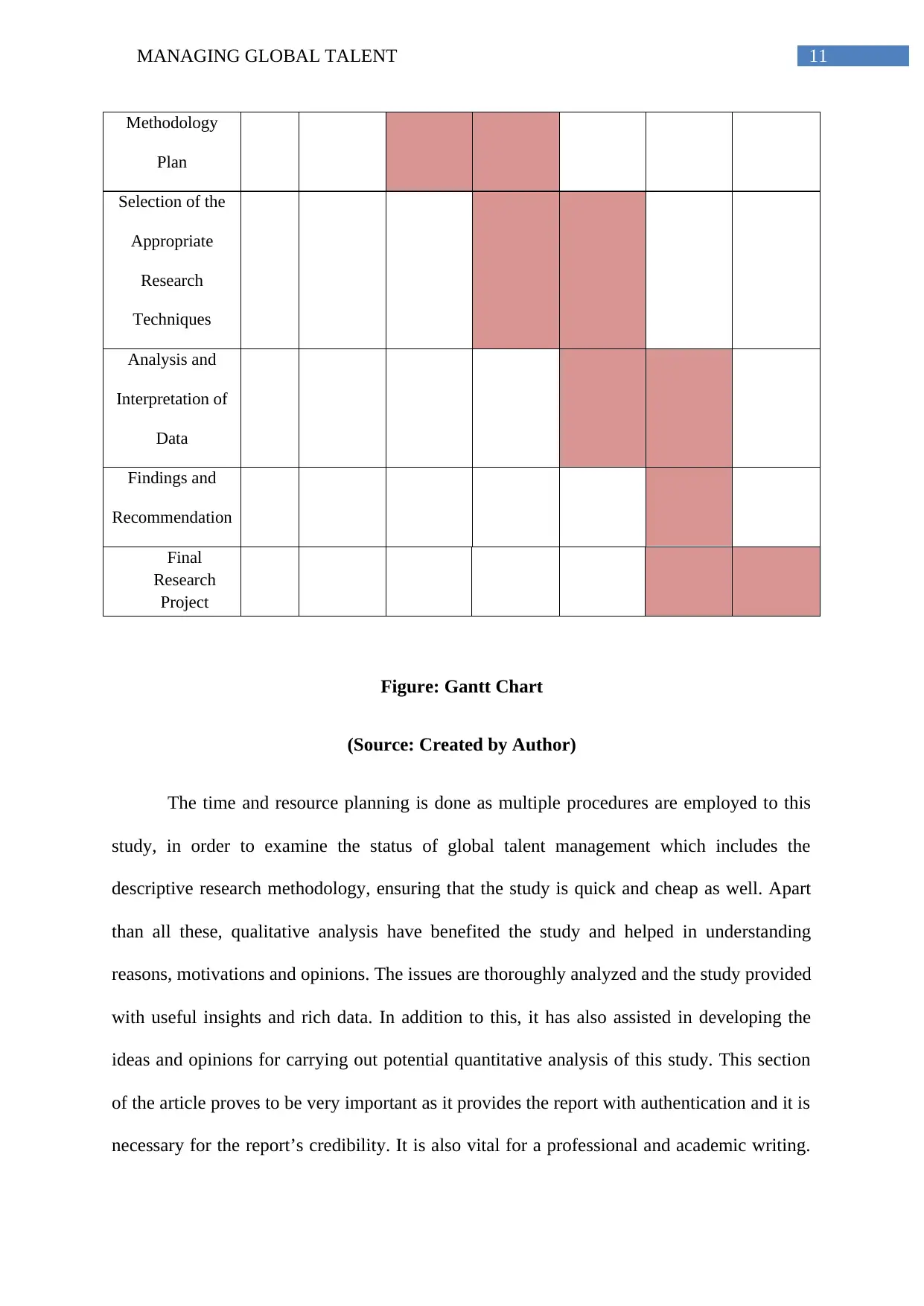
11MANAGING GLOBAL TALENT
Methodology
Plan
Selection of the
Appropriate
Research
Techniques
Analysis and
Interpretation of
Data
Findings and
Recommendation
Final
Research
Project
Figure: Gantt Chart
(Source: Created by Author)
The time and resource planning is done as multiple procedures are employed to this
study, in order to examine the status of global talent management which includes the
descriptive research methodology, ensuring that the study is quick and cheap as well. Apart
than all these, qualitative analysis have benefited the study and helped in understanding
reasons, motivations and opinions. The issues are thoroughly analyzed and the study provided
with useful insights and rich data. In addition to this, it has also assisted in developing the
ideas and opinions for carrying out potential quantitative analysis of this study. This section
of the article proves to be very important as it provides the report with authentication and it is
necessary for the report’s credibility. It is also vital for a professional and academic writing.
Methodology
Plan
Selection of the
Appropriate
Research
Techniques
Analysis and
Interpretation of
Data
Findings and
Recommendation
Final
Research
Project
Figure: Gantt Chart
(Source: Created by Author)
The time and resource planning is done as multiple procedures are employed to this
study, in order to examine the status of global talent management which includes the
descriptive research methodology, ensuring that the study is quick and cheap as well. Apart
than all these, qualitative analysis have benefited the study and helped in understanding
reasons, motivations and opinions. The issues are thoroughly analyzed and the study provided
with useful insights and rich data. In addition to this, it has also assisted in developing the
ideas and opinions for carrying out potential quantitative analysis of this study. This section
of the article proves to be very important as it provides the report with authentication and it is
necessary for the report’s credibility. It is also vital for a professional and academic writing.
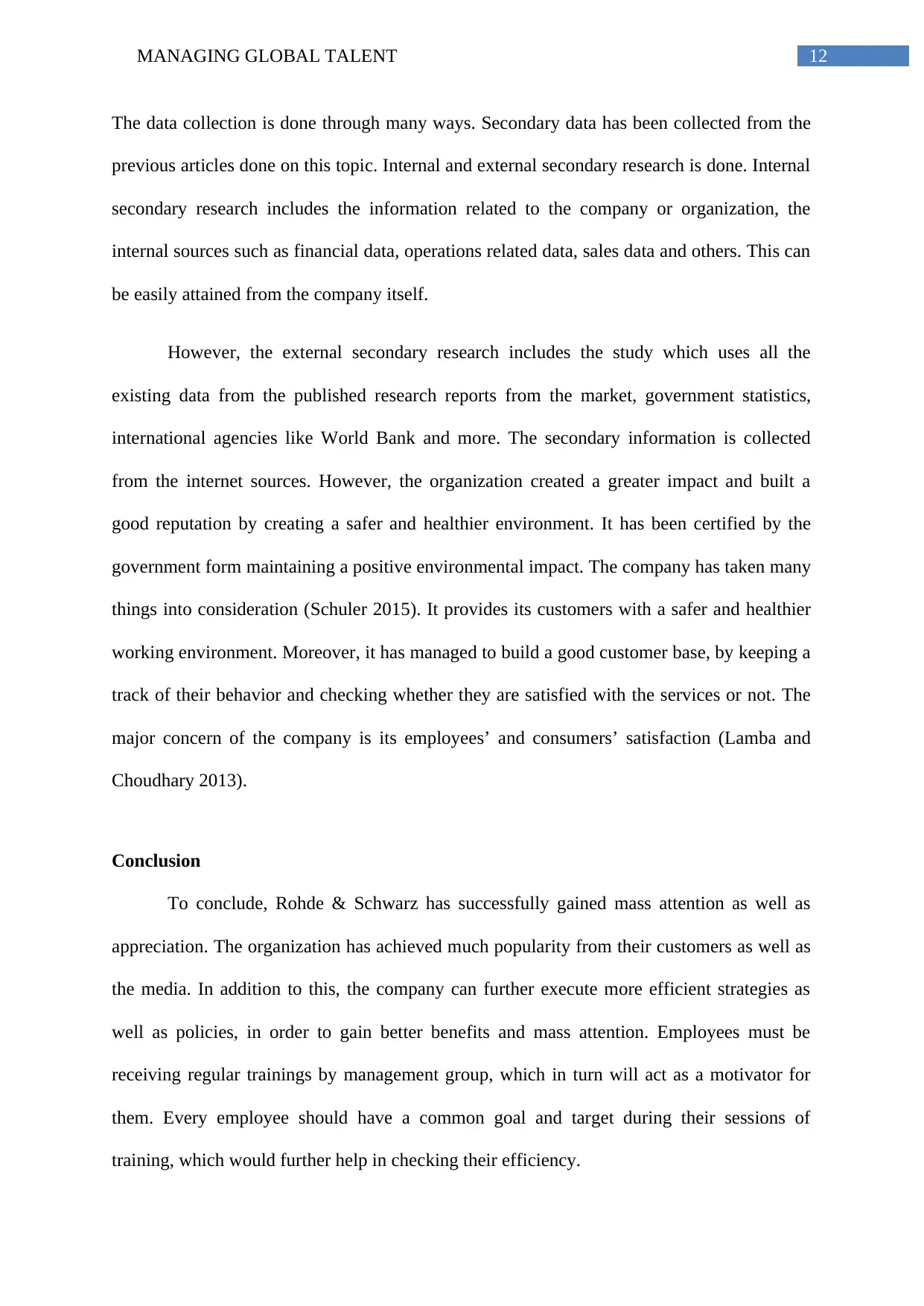
12MANAGING GLOBAL TALENT
The data collection is done through many ways. Secondary data has been collected from the
previous articles done on this topic. Internal and external secondary research is done. Internal
secondary research includes the information related to the company or organization, the
internal sources such as financial data, operations related data, sales data and others. This can
be easily attained from the company itself.
However, the external secondary research includes the study which uses all the
existing data from the published research reports from the market, government statistics,
international agencies like World Bank and more. The secondary information is collected
from the internet sources. However, the organization created a greater impact and built a
good reputation by creating a safer and healthier environment. It has been certified by the
government form maintaining a positive environmental impact. The company has taken many
things into consideration (Schuler 2015). It provides its customers with a safer and healthier
working environment. Moreover, it has managed to build a good customer base, by keeping a
track of their behavior and checking whether they are satisfied with the services or not. The
major concern of the company is its employees’ and consumers’ satisfaction (Lamba and
Choudhary 2013).
Conclusion
To conclude, Rohde & Schwarz has successfully gained mass attention as well as
appreciation. The organization has achieved much popularity from their customers as well as
the media. In addition to this, the company can further execute more efficient strategies as
well as policies, in order to gain better benefits and mass attention. Employees must be
receiving regular trainings by management group, which in turn will act as a motivator for
them. Every employee should have a common goal and target during their sessions of
training, which would further help in checking their efficiency.
The data collection is done through many ways. Secondary data has been collected from the
previous articles done on this topic. Internal and external secondary research is done. Internal
secondary research includes the information related to the company or organization, the
internal sources such as financial data, operations related data, sales data and others. This can
be easily attained from the company itself.
However, the external secondary research includes the study which uses all the
existing data from the published research reports from the market, government statistics,
international agencies like World Bank and more. The secondary information is collected
from the internet sources. However, the organization created a greater impact and built a
good reputation by creating a safer and healthier environment. It has been certified by the
government form maintaining a positive environmental impact. The company has taken many
things into consideration (Schuler 2015). It provides its customers with a safer and healthier
working environment. Moreover, it has managed to build a good customer base, by keeping a
track of their behavior and checking whether they are satisfied with the services or not. The
major concern of the company is its employees’ and consumers’ satisfaction (Lamba and
Choudhary 2013).
Conclusion
To conclude, Rohde & Schwarz has successfully gained mass attention as well as
appreciation. The organization has achieved much popularity from their customers as well as
the media. In addition to this, the company can further execute more efficient strategies as
well as policies, in order to gain better benefits and mass attention. Employees must be
receiving regular trainings by management group, which in turn will act as a motivator for
them. Every employee should have a common goal and target during their sessions of
training, which would further help in checking their efficiency.
Paraphrase This Document
Need a fresh take? Get an instant paraphrase of this document with our AI Paraphraser
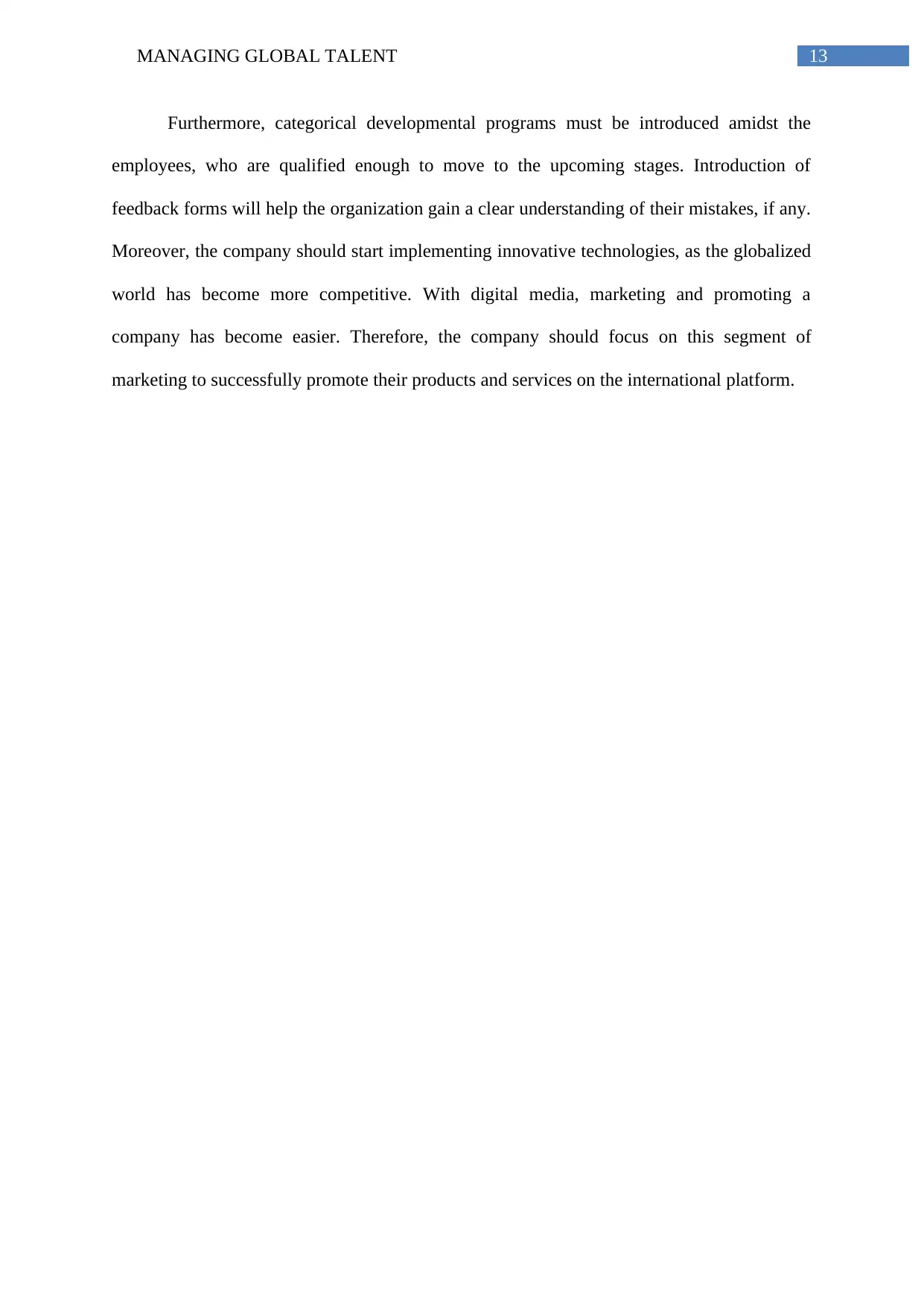
13MANAGING GLOBAL TALENT
Furthermore, categorical developmental programs must be introduced amidst the
employees, who are qualified enough to move to the upcoming stages. Introduction of
feedback forms will help the organization gain a clear understanding of their mistakes, if any.
Moreover, the company should start implementing innovative technologies, as the globalized
world has become more competitive. With digital media, marketing and promoting a
company has become easier. Therefore, the company should focus on this segment of
marketing to successfully promote their products and services on the international platform.
Furthermore, categorical developmental programs must be introduced amidst the
employees, who are qualified enough to move to the upcoming stages. Introduction of
feedback forms will help the organization gain a clear understanding of their mistakes, if any.
Moreover, the company should start implementing innovative technologies, as the globalized
world has become more competitive. With digital media, marketing and promoting a
company has become easier. Therefore, the company should focus on this segment of
marketing to successfully promote their products and services on the international platform.
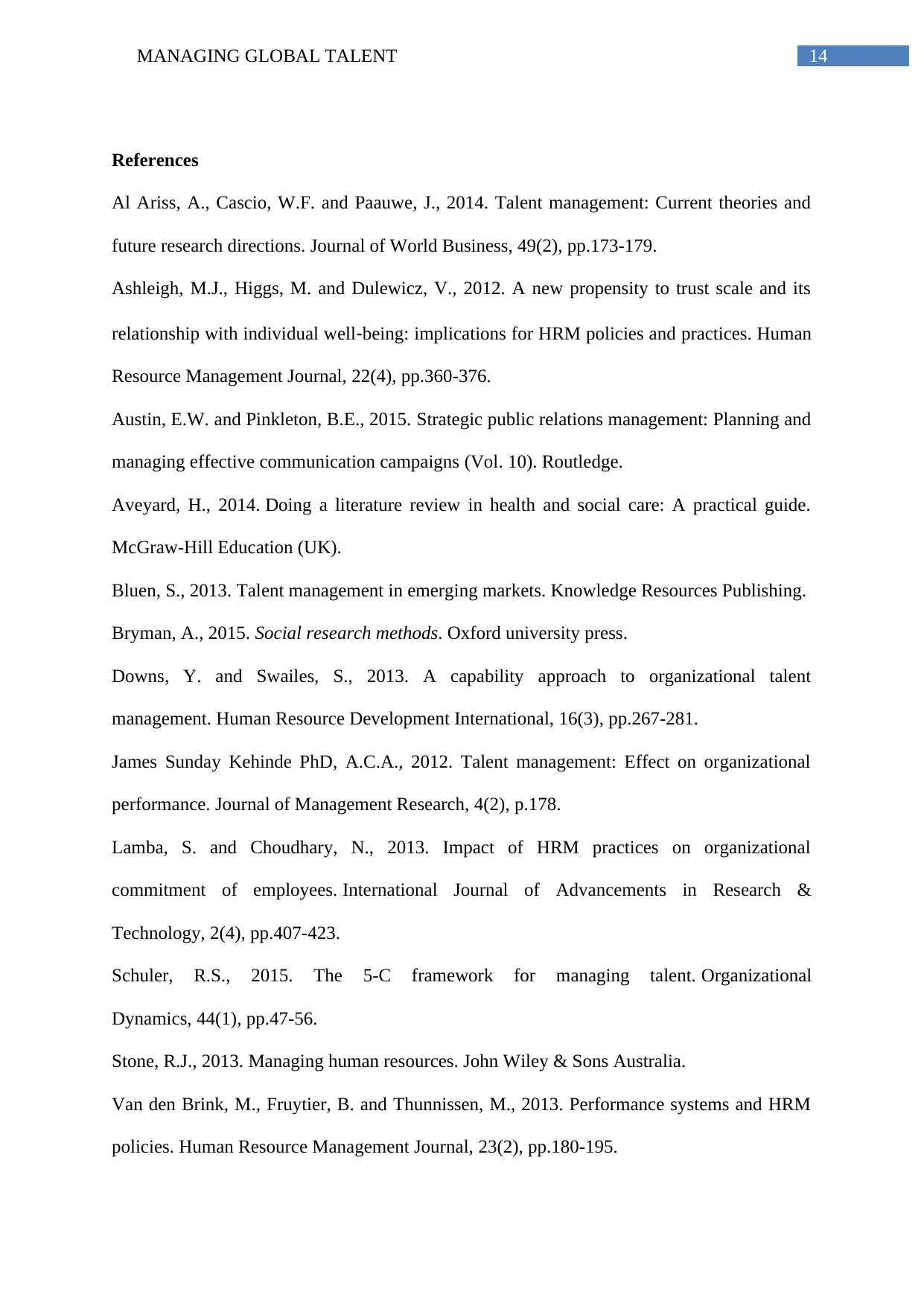
14MANAGING GLOBAL TALENT
References
Al Ariss, A., Cascio, W.F. and Paauwe, J., 2014. Talent management: Current theories and
future research directions. Journal of World Business, 49(2), pp.173-179.
Ashleigh, M.J., Higgs, M. and Dulewicz, V., 2012. A new propensity to trust scale and its
relationship with individual well‐being: implications for HRM policies and practices. Human
Resource Management Journal, 22(4), pp.360-376.
Austin, E.W. and Pinkleton, B.E., 2015. Strategic public relations management: Planning and
managing effective communication campaigns (Vol. 10). Routledge.
Aveyard, H., 2014. Doing a literature review in health and social care: A practical guide.
McGraw-Hill Education (UK).
Bluen, S., 2013. Talent management in emerging markets. Knowledge Resources Publishing.
Bryman, A., 2015. Social research methods. Oxford university press.
Downs, Y. and Swailes, S., 2013. A capability approach to organizational talent
management. Human Resource Development International, 16(3), pp.267-281.
James Sunday Kehinde PhD, A.C.A., 2012. Talent management: Effect on organizational
performance. Journal of Management Research, 4(2), p.178.
Lamba, S. and Choudhary, N., 2013. Impact of HRM practices on organizational
commitment of employees. International Journal of Advancements in Research &
Technology, 2(4), pp.407-423.
Schuler, R.S., 2015. The 5-C framework for managing talent. Organizational
Dynamics, 44(1), pp.47-56.
Stone, R.J., 2013. Managing human resources. John Wiley & Sons Australia.
Van den Brink, M., Fruytier, B. and Thunnissen, M., 2013. Performance systems and HRM
policies. Human Resource Management Journal, 23(2), pp.180-195.
References
Al Ariss, A., Cascio, W.F. and Paauwe, J., 2014. Talent management: Current theories and
future research directions. Journal of World Business, 49(2), pp.173-179.
Ashleigh, M.J., Higgs, M. and Dulewicz, V., 2012. A new propensity to trust scale and its
relationship with individual well‐being: implications for HRM policies and practices. Human
Resource Management Journal, 22(4), pp.360-376.
Austin, E.W. and Pinkleton, B.E., 2015. Strategic public relations management: Planning and
managing effective communication campaigns (Vol. 10). Routledge.
Aveyard, H., 2014. Doing a literature review in health and social care: A practical guide.
McGraw-Hill Education (UK).
Bluen, S., 2013. Talent management in emerging markets. Knowledge Resources Publishing.
Bryman, A., 2015. Social research methods. Oxford university press.
Downs, Y. and Swailes, S., 2013. A capability approach to organizational talent
management. Human Resource Development International, 16(3), pp.267-281.
James Sunday Kehinde PhD, A.C.A., 2012. Talent management: Effect on organizational
performance. Journal of Management Research, 4(2), p.178.
Lamba, S. and Choudhary, N., 2013. Impact of HRM practices on organizational
commitment of employees. International Journal of Advancements in Research &
Technology, 2(4), pp.407-423.
Schuler, R.S., 2015. The 5-C framework for managing talent. Organizational
Dynamics, 44(1), pp.47-56.
Stone, R.J., 2013. Managing human resources. John Wiley & Sons Australia.
Van den Brink, M., Fruytier, B. and Thunnissen, M., 2013. Performance systems and HRM
policies. Human Resource Management Journal, 23(2), pp.180-195.
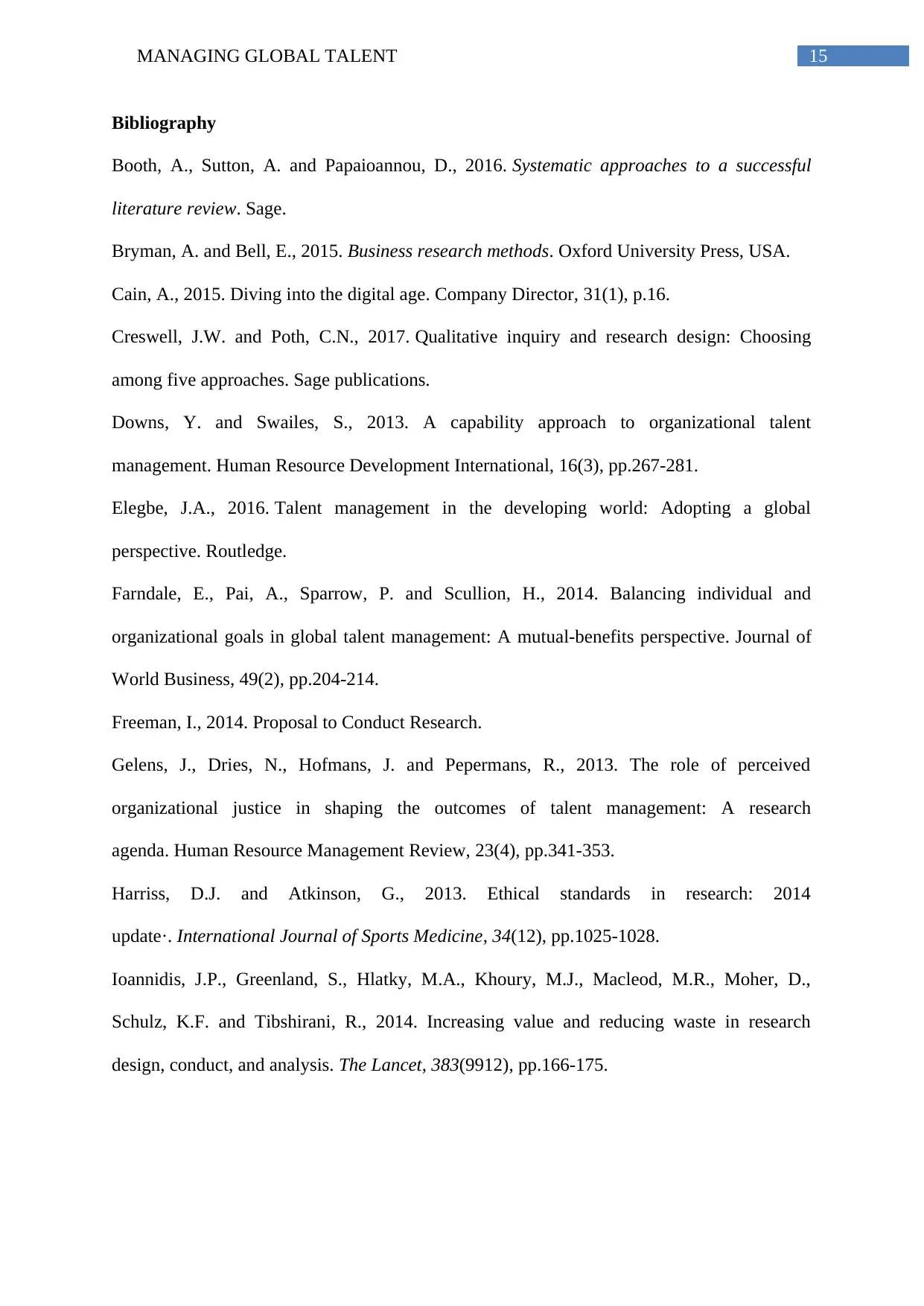
15MANAGING GLOBAL TALENT
Bibliography
Booth, A., Sutton, A. and Papaioannou, D., 2016. Systematic approaches to a successful
literature review. Sage.
Bryman, A. and Bell, E., 2015. Business research methods. Oxford University Press, USA.
Cain, A., 2015. Diving into the digital age. Company Director, 31(1), p.16.
Creswell, J.W. and Poth, C.N., 2017. Qualitative inquiry and research design: Choosing
among five approaches. Sage publications.
Downs, Y. and Swailes, S., 2013. A capability approach to organizational talent
management. Human Resource Development International, 16(3), pp.267-281.
Elegbe, J.A., 2016. Talent management in the developing world: Adopting a global
perspective. Routledge.
Farndale, E., Pai, A., Sparrow, P. and Scullion, H., 2014. Balancing individual and
organizational goals in global talent management: A mutual-benefits perspective. Journal of
World Business, 49(2), pp.204-214.
Freeman, I., 2014. Proposal to Conduct Research.
Gelens, J., Dries, N., Hofmans, J. and Pepermans, R., 2013. The role of perceived
organizational justice in shaping the outcomes of talent management: A research
agenda. Human Resource Management Review, 23(4), pp.341-353.
Harriss, D.J. and Atkinson, G., 2013. Ethical standards in research: 2014
update·. International Journal of Sports Medicine, 34(12), pp.1025-1028.
Ioannidis, J.P., Greenland, S., Hlatky, M.A., Khoury, M.J., Macleod, M.R., Moher, D.,
Schulz, K.F. and Tibshirani, R., 2014. Increasing value and reducing waste in research
design, conduct, and analysis. The Lancet, 383(9912), pp.166-175.
Bibliography
Booth, A., Sutton, A. and Papaioannou, D., 2016. Systematic approaches to a successful
literature review. Sage.
Bryman, A. and Bell, E., 2015. Business research methods. Oxford University Press, USA.
Cain, A., 2015. Diving into the digital age. Company Director, 31(1), p.16.
Creswell, J.W. and Poth, C.N., 2017. Qualitative inquiry and research design: Choosing
among five approaches. Sage publications.
Downs, Y. and Swailes, S., 2013. A capability approach to organizational talent
management. Human Resource Development International, 16(3), pp.267-281.
Elegbe, J.A., 2016. Talent management in the developing world: Adopting a global
perspective. Routledge.
Farndale, E., Pai, A., Sparrow, P. and Scullion, H., 2014. Balancing individual and
organizational goals in global talent management: A mutual-benefits perspective. Journal of
World Business, 49(2), pp.204-214.
Freeman, I., 2014. Proposal to Conduct Research.
Gelens, J., Dries, N., Hofmans, J. and Pepermans, R., 2013. The role of perceived
organizational justice in shaping the outcomes of talent management: A research
agenda. Human Resource Management Review, 23(4), pp.341-353.
Harriss, D.J. and Atkinson, G., 2013. Ethical standards in research: 2014
update·. International Journal of Sports Medicine, 34(12), pp.1025-1028.
Ioannidis, J.P., Greenland, S., Hlatky, M.A., Khoury, M.J., Macleod, M.R., Moher, D.,
Schulz, K.F. and Tibshirani, R., 2014. Increasing value and reducing waste in research
design, conduct, and analysis. The Lancet, 383(9912), pp.166-175.
Secure Best Marks with AI Grader
Need help grading? Try our AI Grader for instant feedback on your assignments.
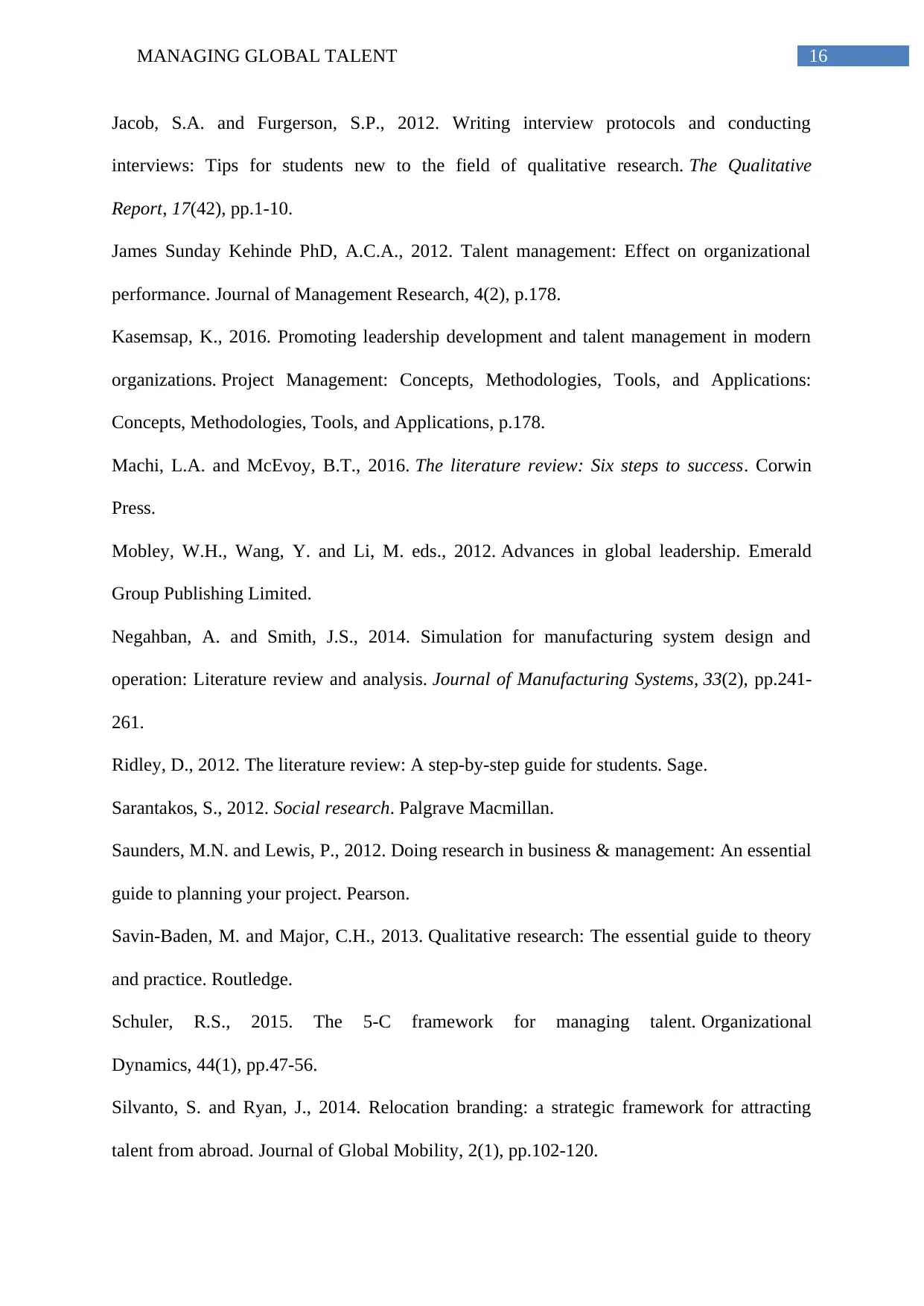
16MANAGING GLOBAL TALENT
Jacob, S.A. and Furgerson, S.P., 2012. Writing interview protocols and conducting
interviews: Tips for students new to the field of qualitative research. The Qualitative
Report, 17(42), pp.1-10.
James Sunday Kehinde PhD, A.C.A., 2012. Talent management: Effect on organizational
performance. Journal of Management Research, 4(2), p.178.
Kasemsap, K., 2016. Promoting leadership development and talent management in modern
organizations. Project Management: Concepts, Methodologies, Tools, and Applications:
Concepts, Methodologies, Tools, and Applications, p.178.
Machi, L.A. and McEvoy, B.T., 2016. The literature review: Six steps to success. Corwin
Press.
Mobley, W.H., Wang, Y. and Li, M. eds., 2012. Advances in global leadership. Emerald
Group Publishing Limited.
Negahban, A. and Smith, J.S., 2014. Simulation for manufacturing system design and
operation: Literature review and analysis. Journal of Manufacturing Systems, 33(2), pp.241-
261.
Ridley, D., 2012. The literature review: A step-by-step guide for students. Sage.
Sarantakos, S., 2012. Social research. Palgrave Macmillan.
Saunders, M.N. and Lewis, P., 2012. Doing research in business & management: An essential
guide to planning your project. Pearson.
Savin-Baden, M. and Major, C.H., 2013. Qualitative research: The essential guide to theory
and practice. Routledge.
Schuler, R.S., 2015. The 5-C framework for managing talent. Organizational
Dynamics, 44(1), pp.47-56.
Silvanto, S. and Ryan, J., 2014. Relocation branding: a strategic framework for attracting
talent from abroad. Journal of Global Mobility, 2(1), pp.102-120.
Jacob, S.A. and Furgerson, S.P., 2012. Writing interview protocols and conducting
interviews: Tips for students new to the field of qualitative research. The Qualitative
Report, 17(42), pp.1-10.
James Sunday Kehinde PhD, A.C.A., 2012. Talent management: Effect on organizational
performance. Journal of Management Research, 4(2), p.178.
Kasemsap, K., 2016. Promoting leadership development and talent management in modern
organizations. Project Management: Concepts, Methodologies, Tools, and Applications:
Concepts, Methodologies, Tools, and Applications, p.178.
Machi, L.A. and McEvoy, B.T., 2016. The literature review: Six steps to success. Corwin
Press.
Mobley, W.H., Wang, Y. and Li, M. eds., 2012. Advances in global leadership. Emerald
Group Publishing Limited.
Negahban, A. and Smith, J.S., 2014. Simulation for manufacturing system design and
operation: Literature review and analysis. Journal of Manufacturing Systems, 33(2), pp.241-
261.
Ridley, D., 2012. The literature review: A step-by-step guide for students. Sage.
Sarantakos, S., 2012. Social research. Palgrave Macmillan.
Saunders, M.N. and Lewis, P., 2012. Doing research in business & management: An essential
guide to planning your project. Pearson.
Savin-Baden, M. and Major, C.H., 2013. Qualitative research: The essential guide to theory
and practice. Routledge.
Schuler, R.S., 2015. The 5-C framework for managing talent. Organizational
Dynamics, 44(1), pp.47-56.
Silvanto, S. and Ryan, J., 2014. Relocation branding: a strategic framework for attracting
talent from abroad. Journal of Global Mobility, 2(1), pp.102-120.
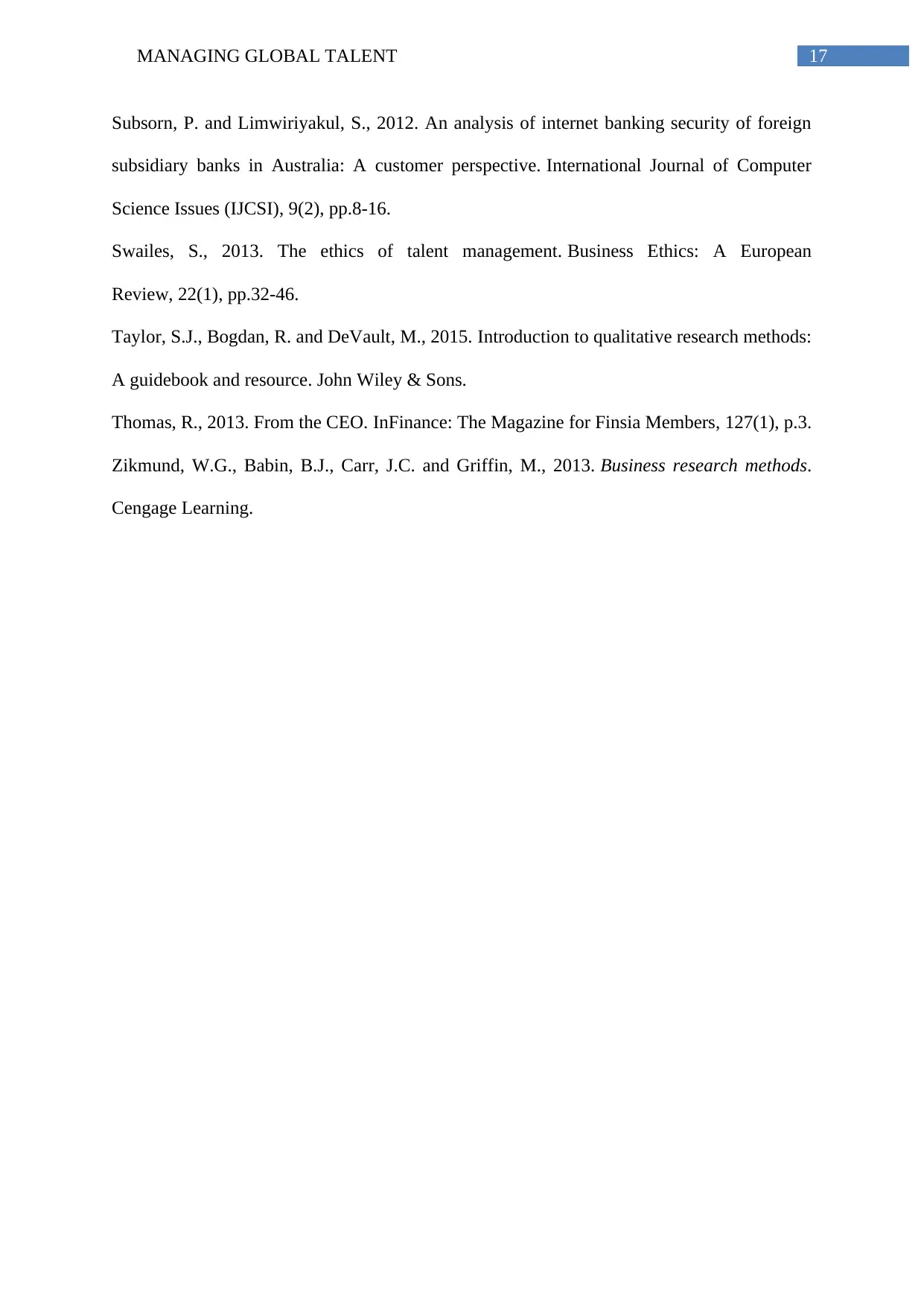
17MANAGING GLOBAL TALENT
Subsorn, P. and Limwiriyakul, S., 2012. An analysis of internet banking security of foreign
subsidiary banks in Australia: A customer perspective. International Journal of Computer
Science Issues (IJCSI), 9(2), pp.8-16.
Swailes, S., 2013. The ethics of talent management. Business Ethics: A European
Review, 22(1), pp.32-46.
Taylor, S.J., Bogdan, R. and DeVault, M., 2015. Introduction to qualitative research methods:
A guidebook and resource. John Wiley & Sons.
Thomas, R., 2013. From the CEO. InFinance: The Magazine for Finsia Members, 127(1), p.3.
Zikmund, W.G., Babin, B.J., Carr, J.C. and Griffin, M., 2013. Business research methods.
Cengage Learning.
Subsorn, P. and Limwiriyakul, S., 2012. An analysis of internet banking security of foreign
subsidiary banks in Australia: A customer perspective. International Journal of Computer
Science Issues (IJCSI), 9(2), pp.8-16.
Swailes, S., 2013. The ethics of talent management. Business Ethics: A European
Review, 22(1), pp.32-46.
Taylor, S.J., Bogdan, R. and DeVault, M., 2015. Introduction to qualitative research methods:
A guidebook and resource. John Wiley & Sons.
Thomas, R., 2013. From the CEO. InFinance: The Magazine for Finsia Members, 127(1), p.3.
Zikmund, W.G., Babin, B.J., Carr, J.C. and Griffin, M., 2013. Business research methods.
Cengage Learning.
1 out of 18
Related Documents
Your All-in-One AI-Powered Toolkit for Academic Success.
+13062052269
info@desklib.com
Available 24*7 on WhatsApp / Email
![[object Object]](/_next/static/media/star-bottom.7253800d.svg)
Unlock your academic potential
© 2024 | Zucol Services PVT LTD | All rights reserved.





